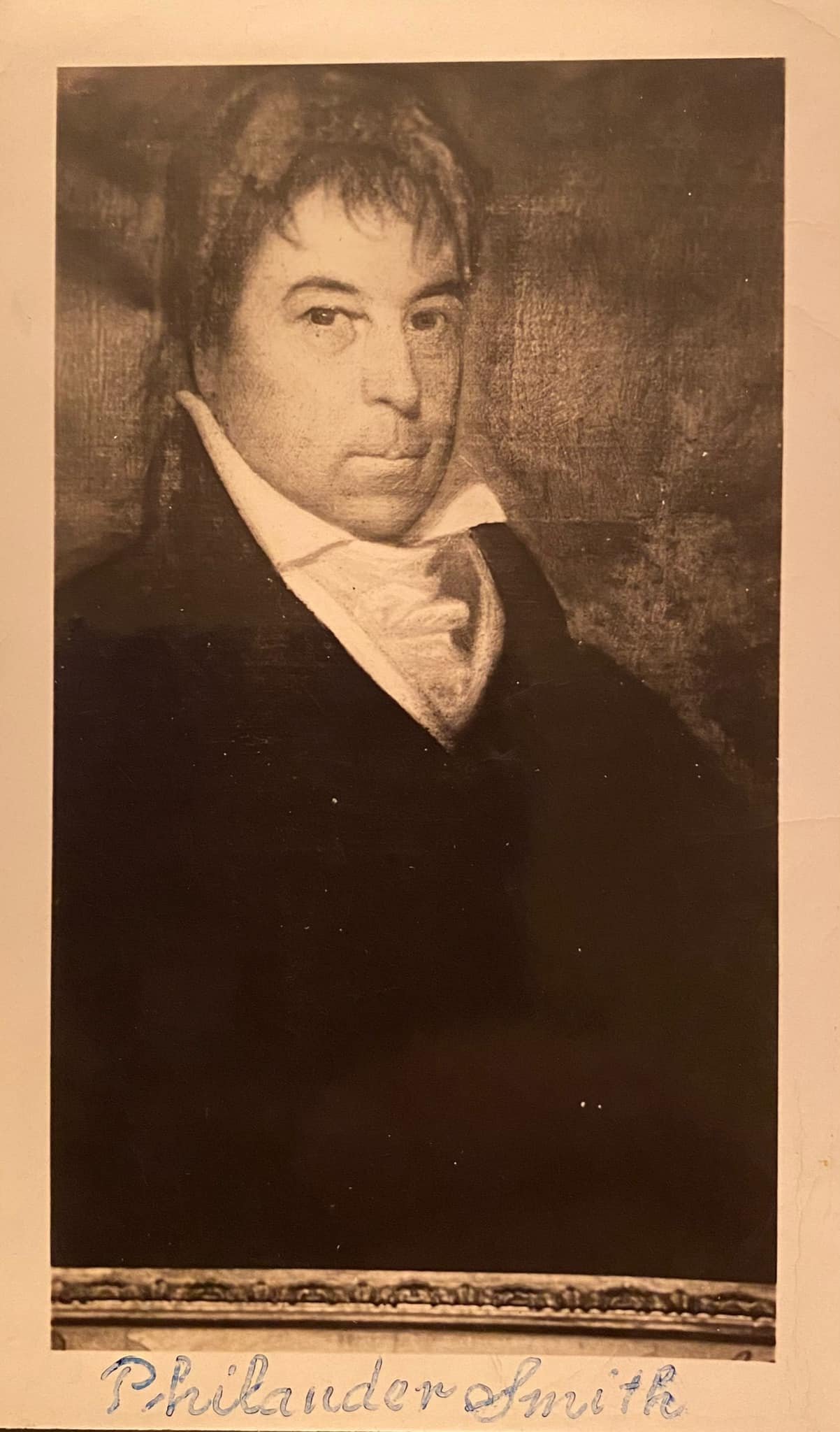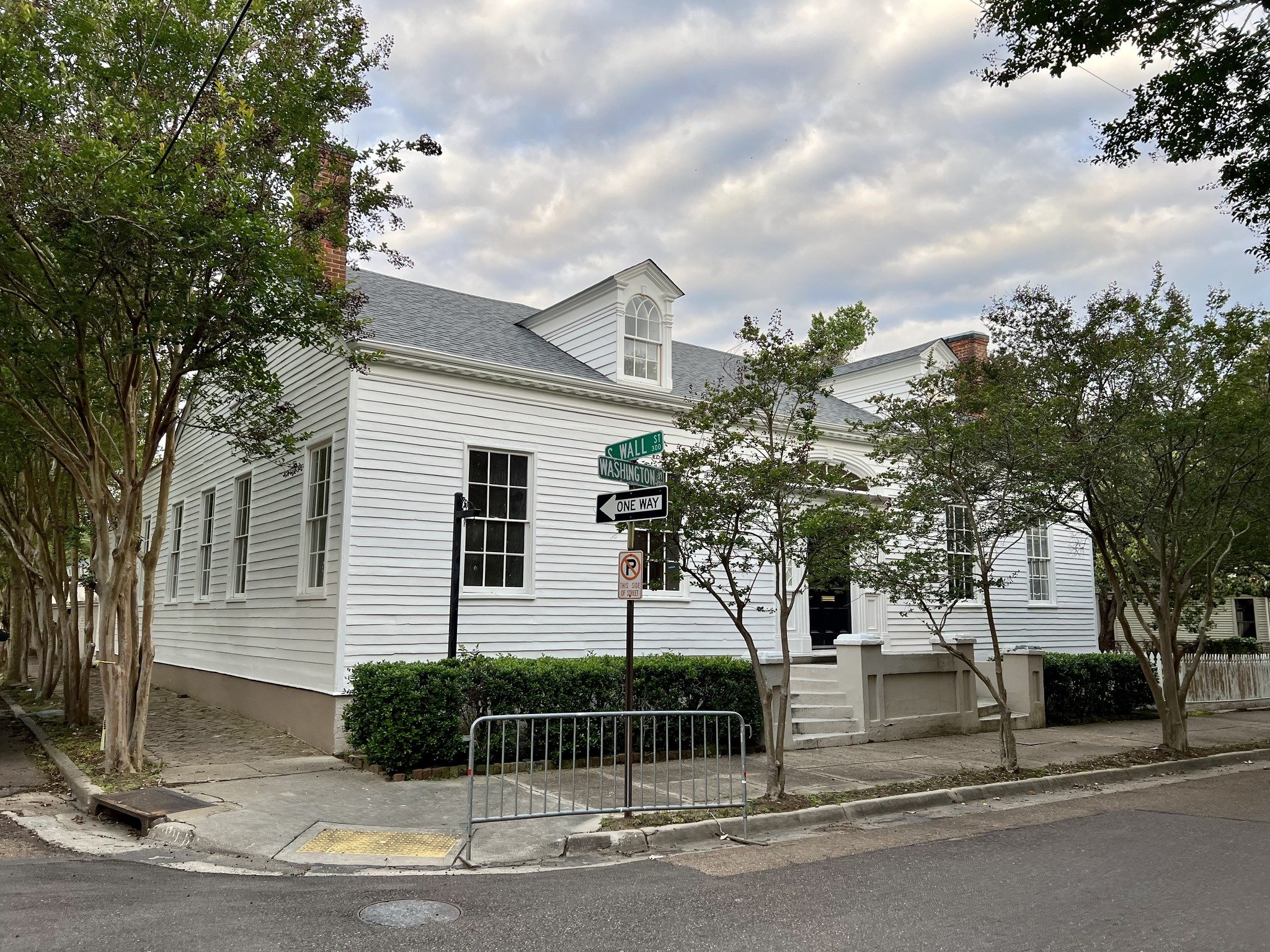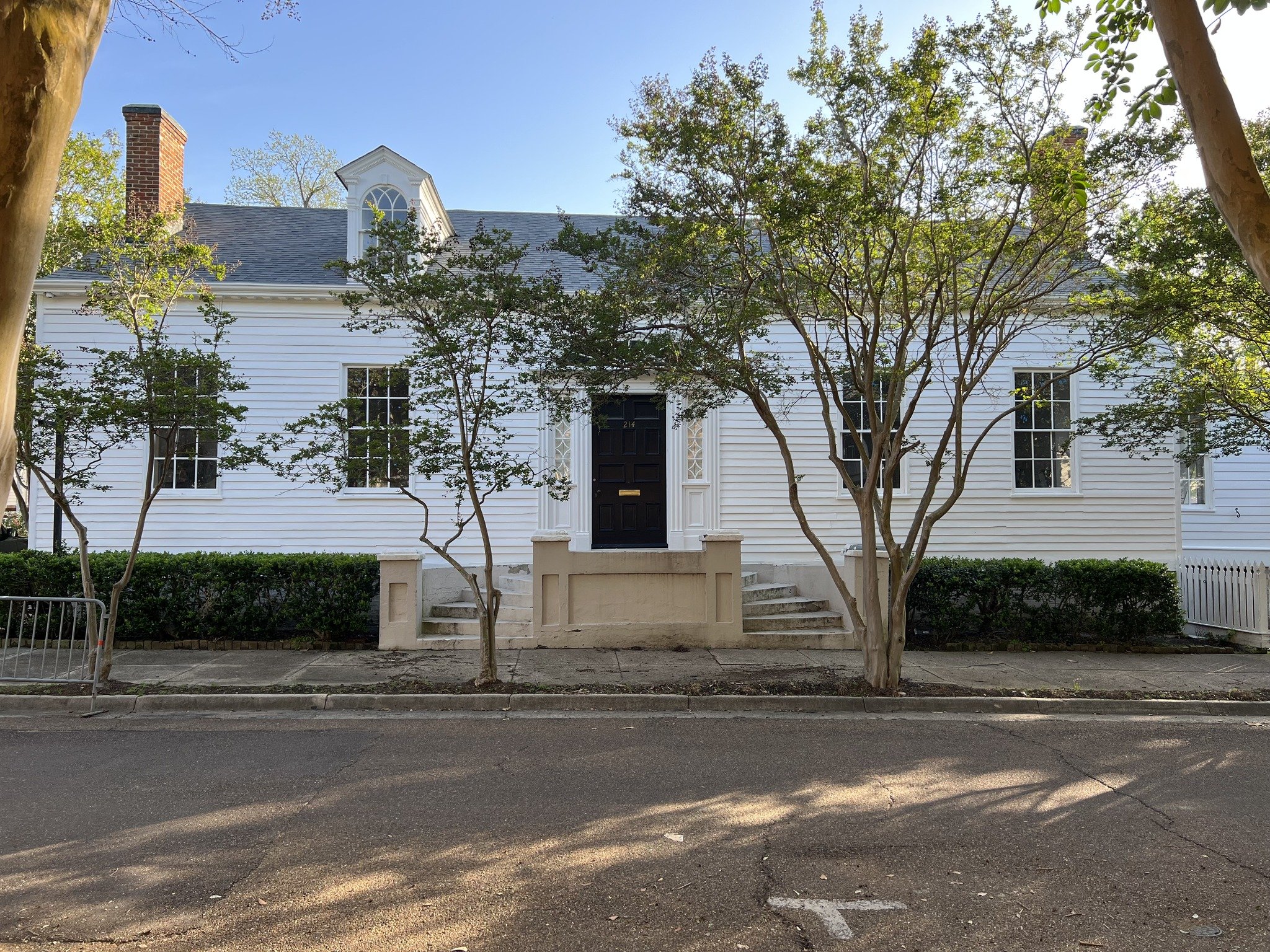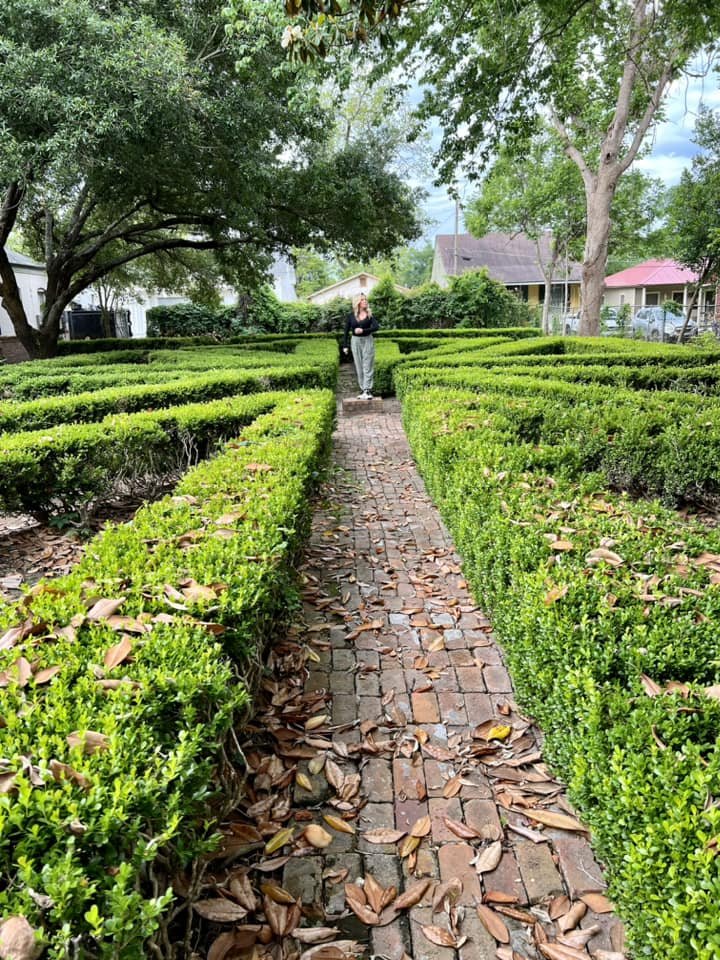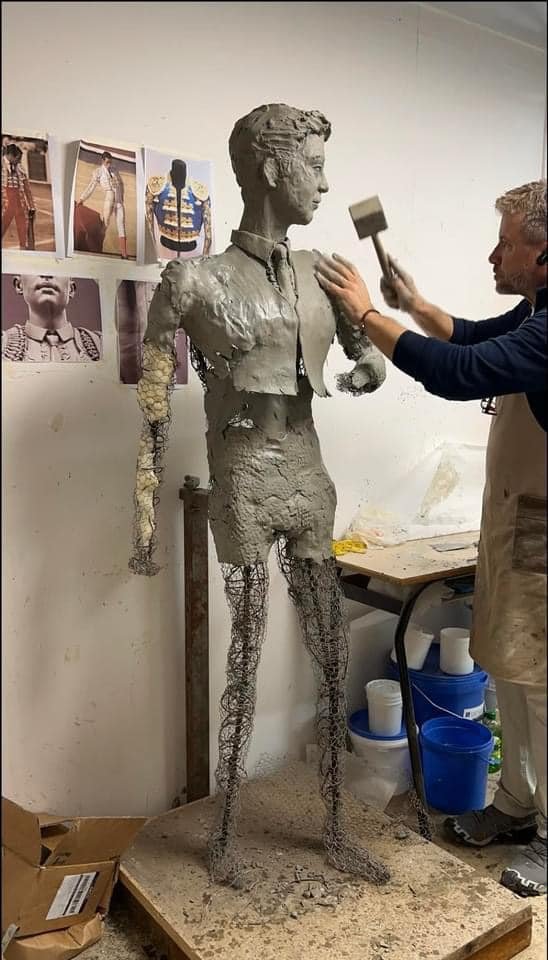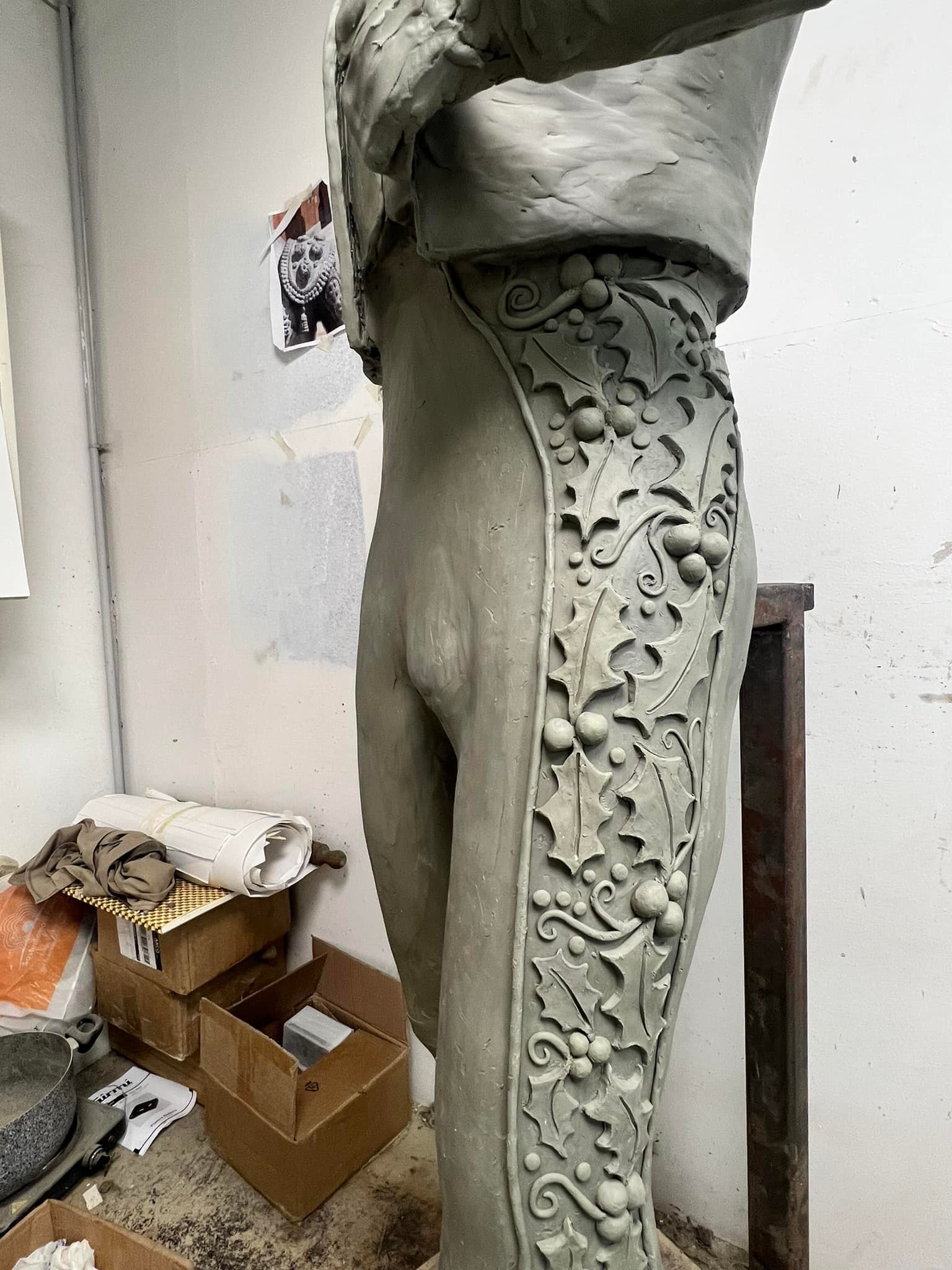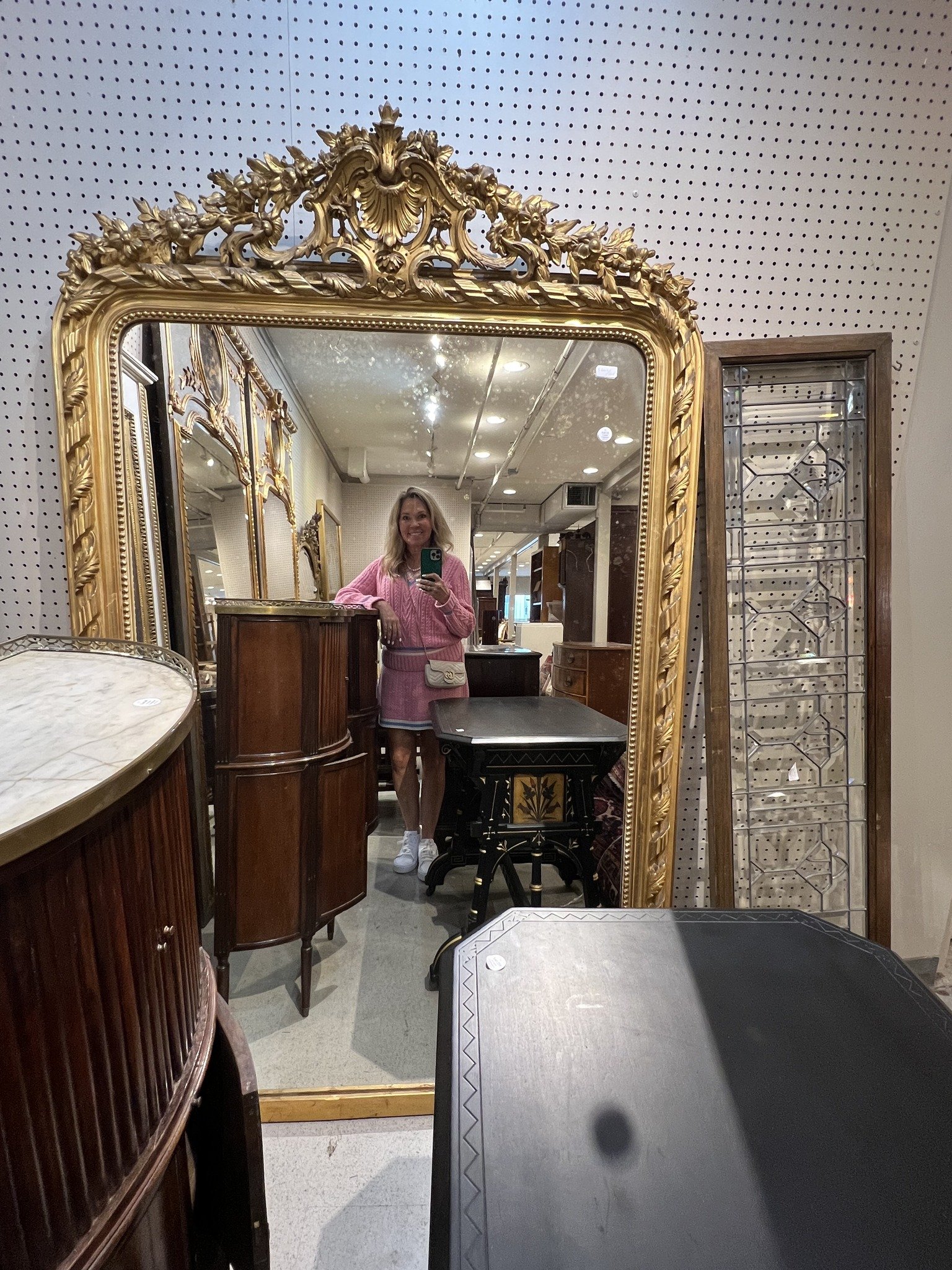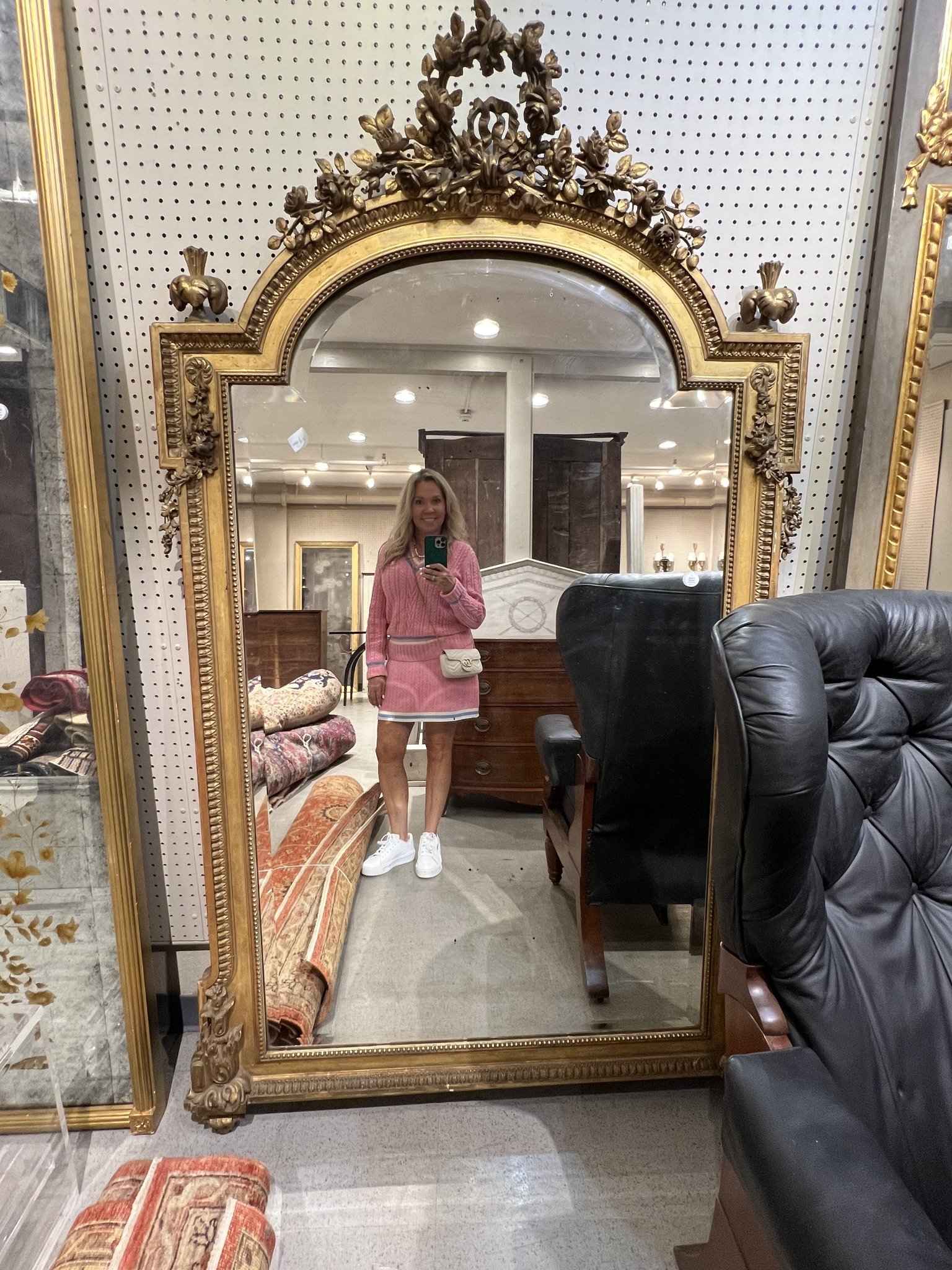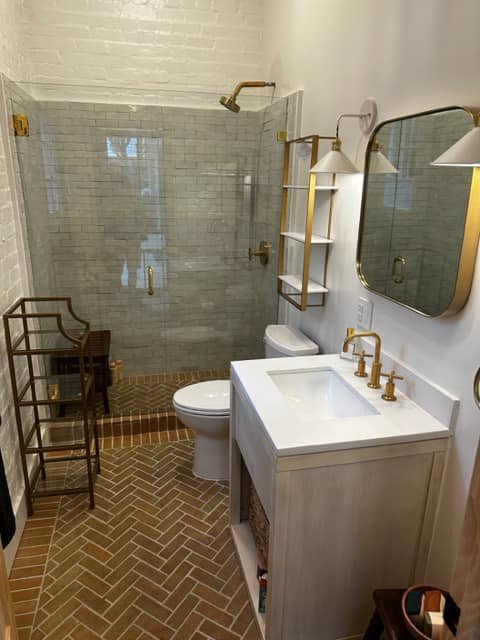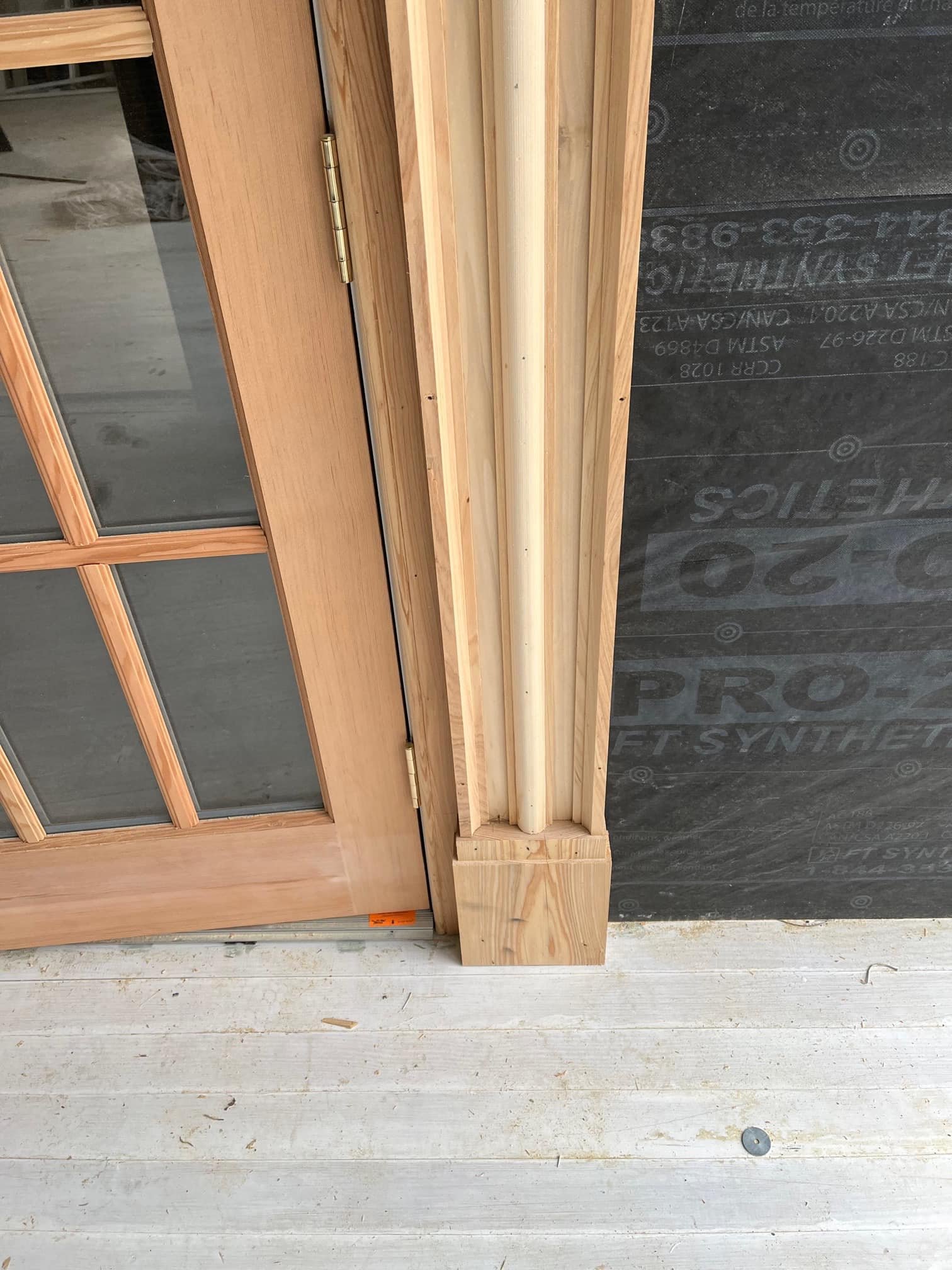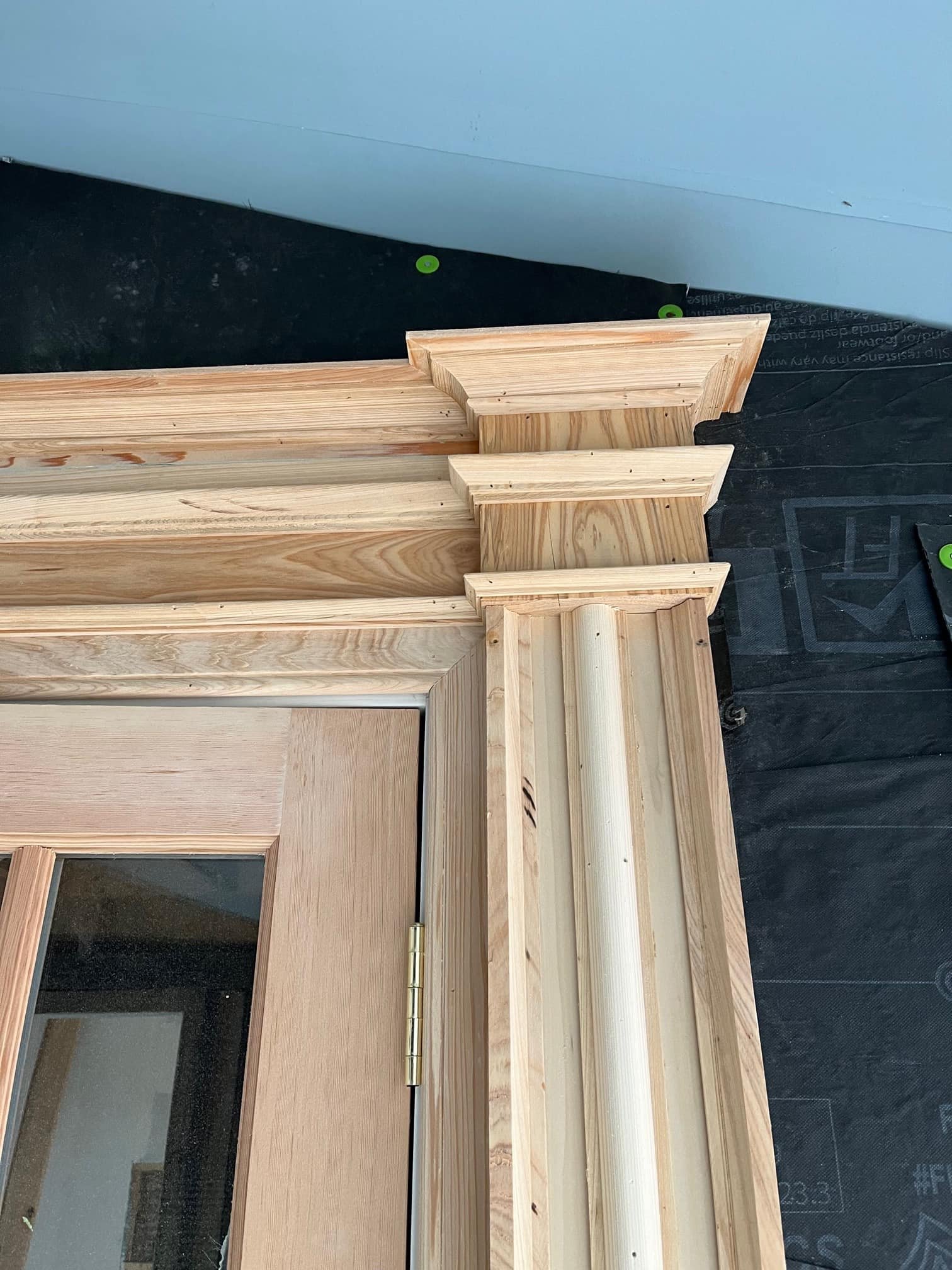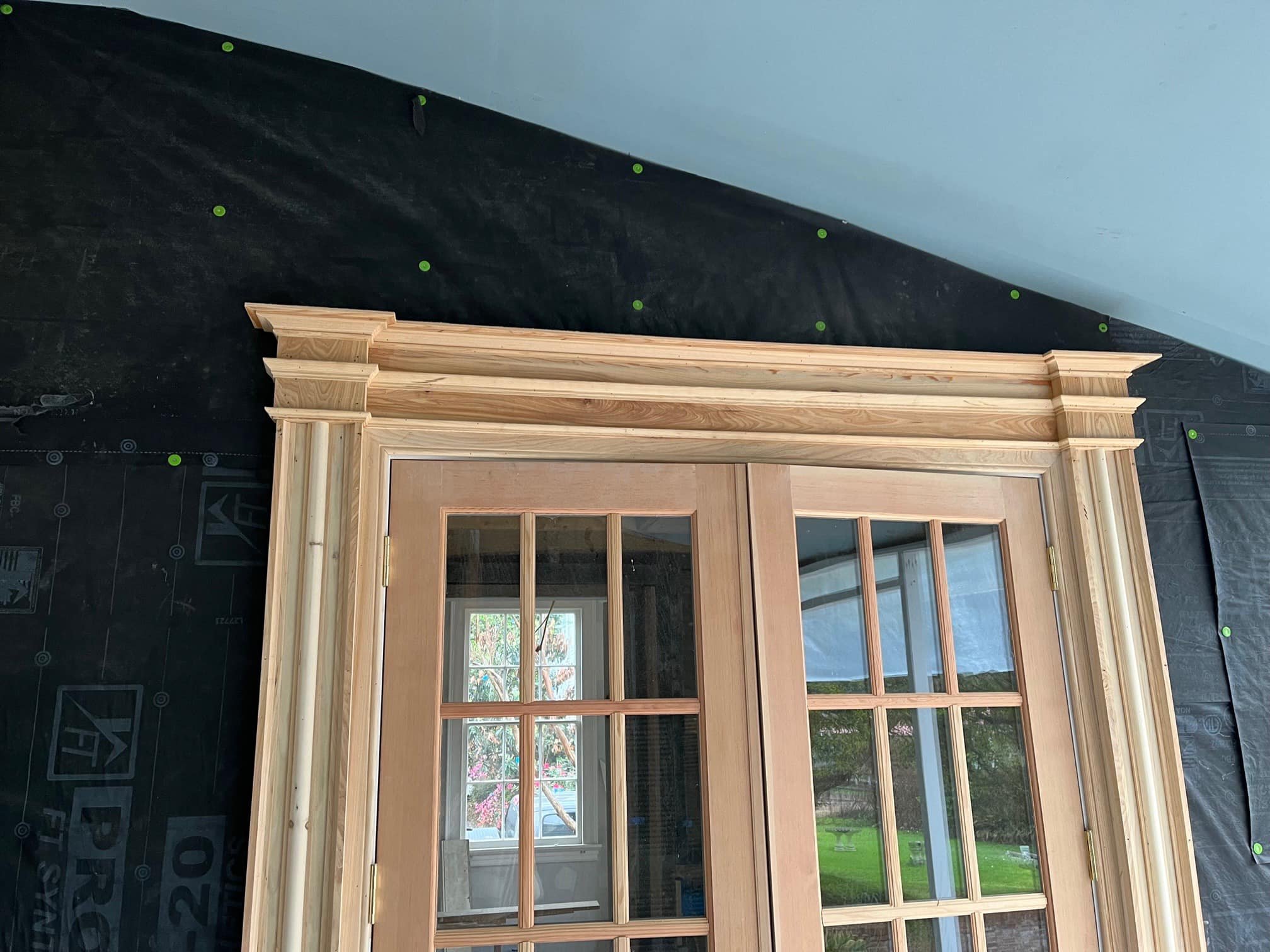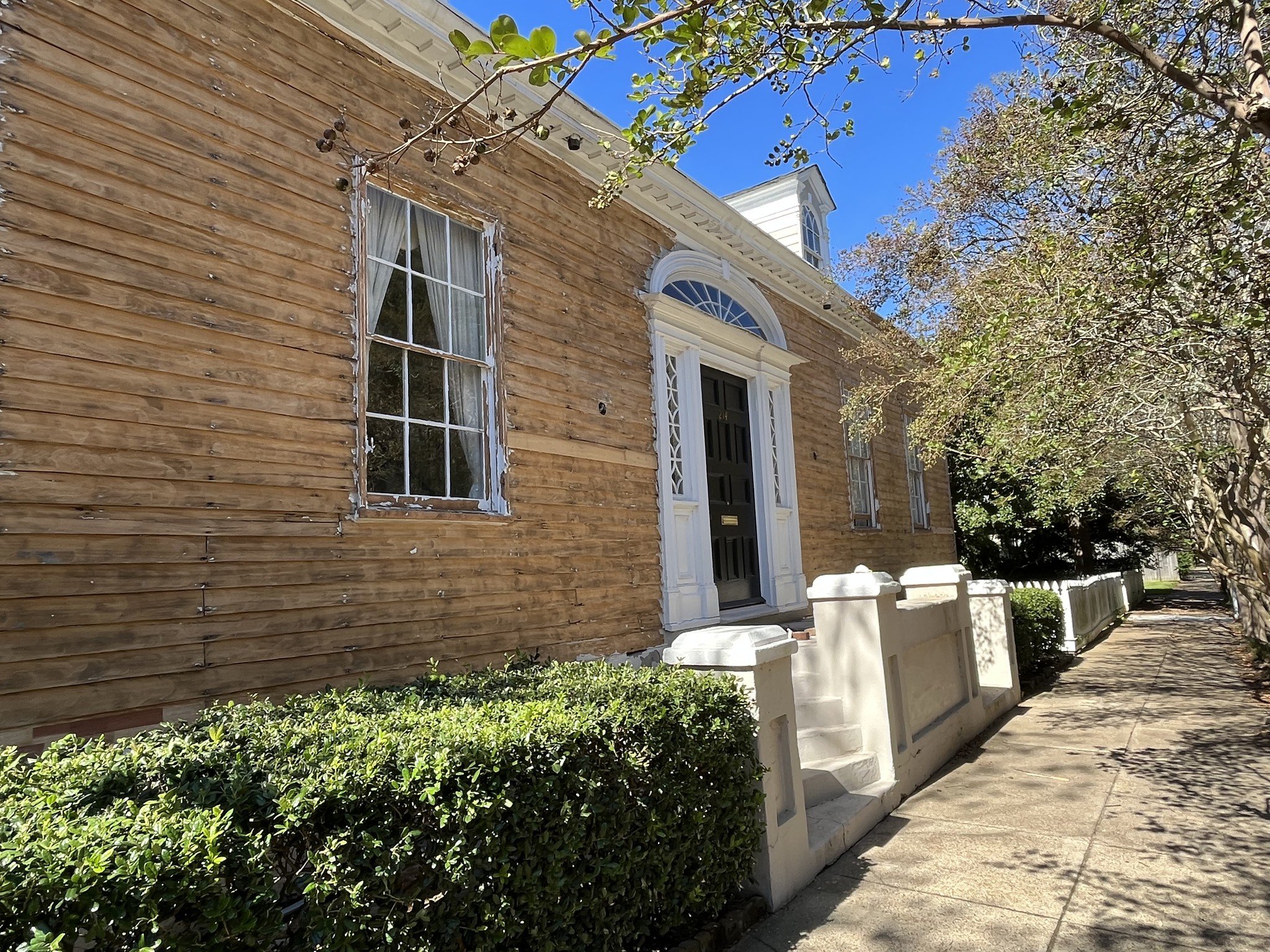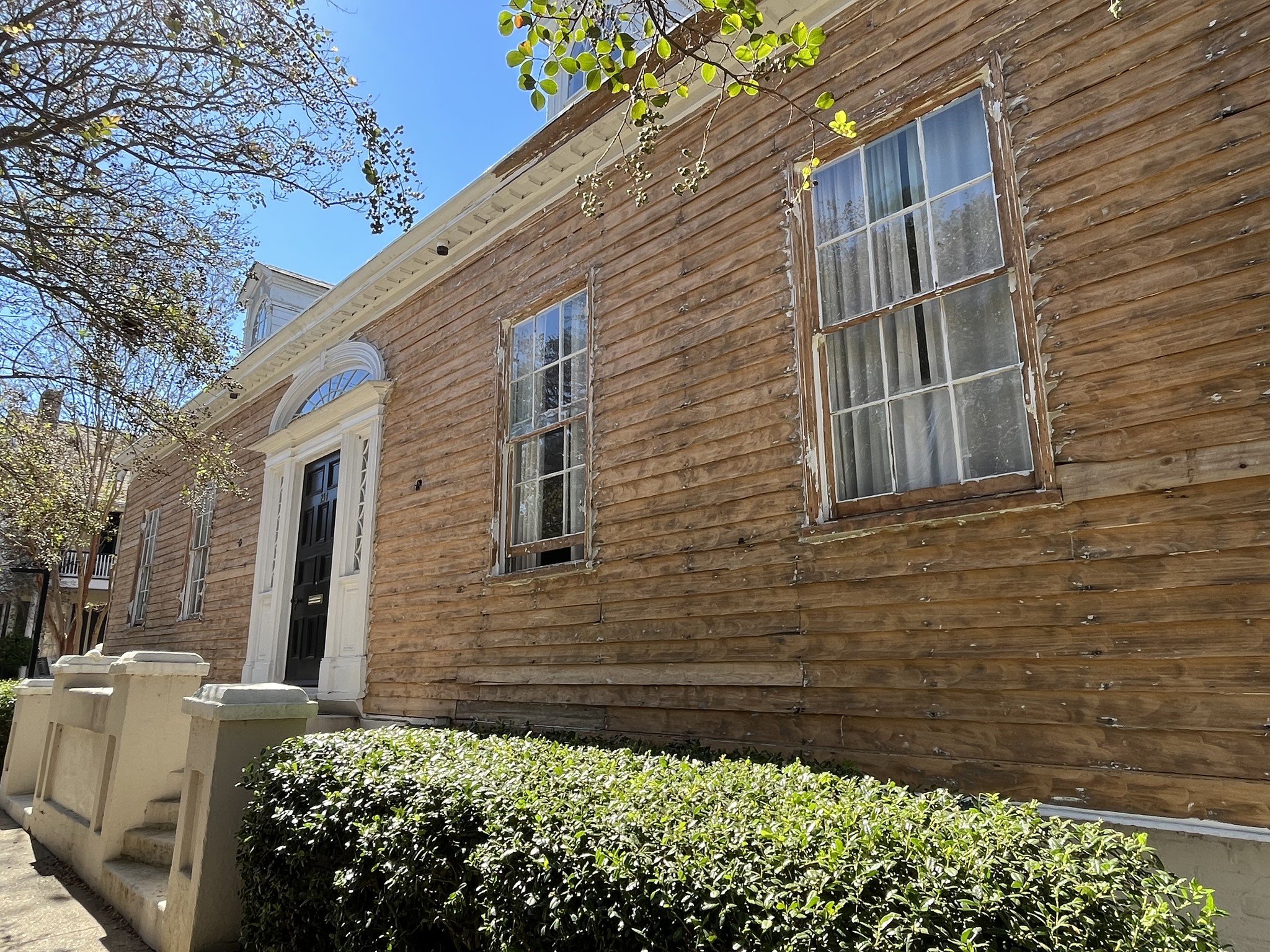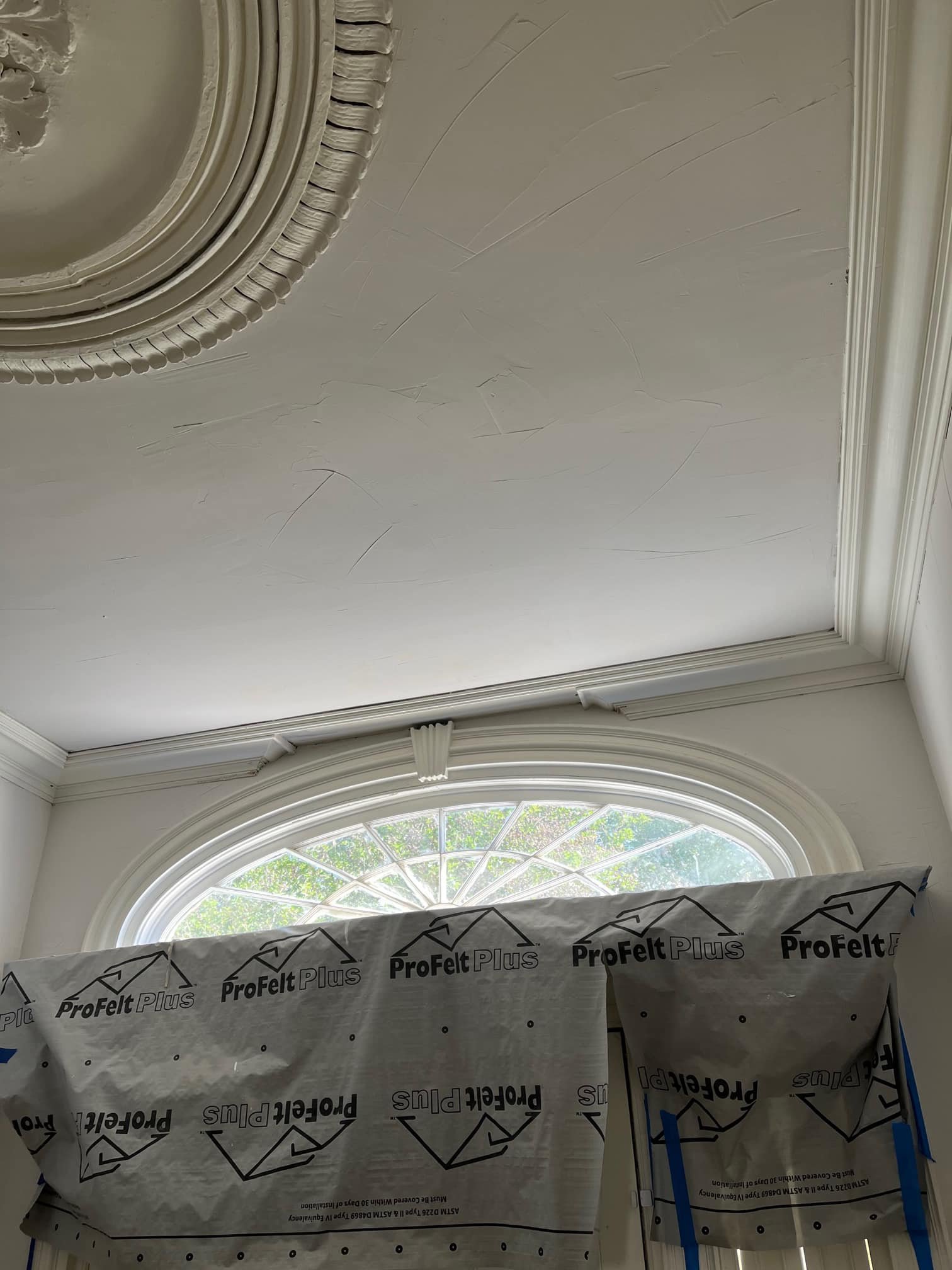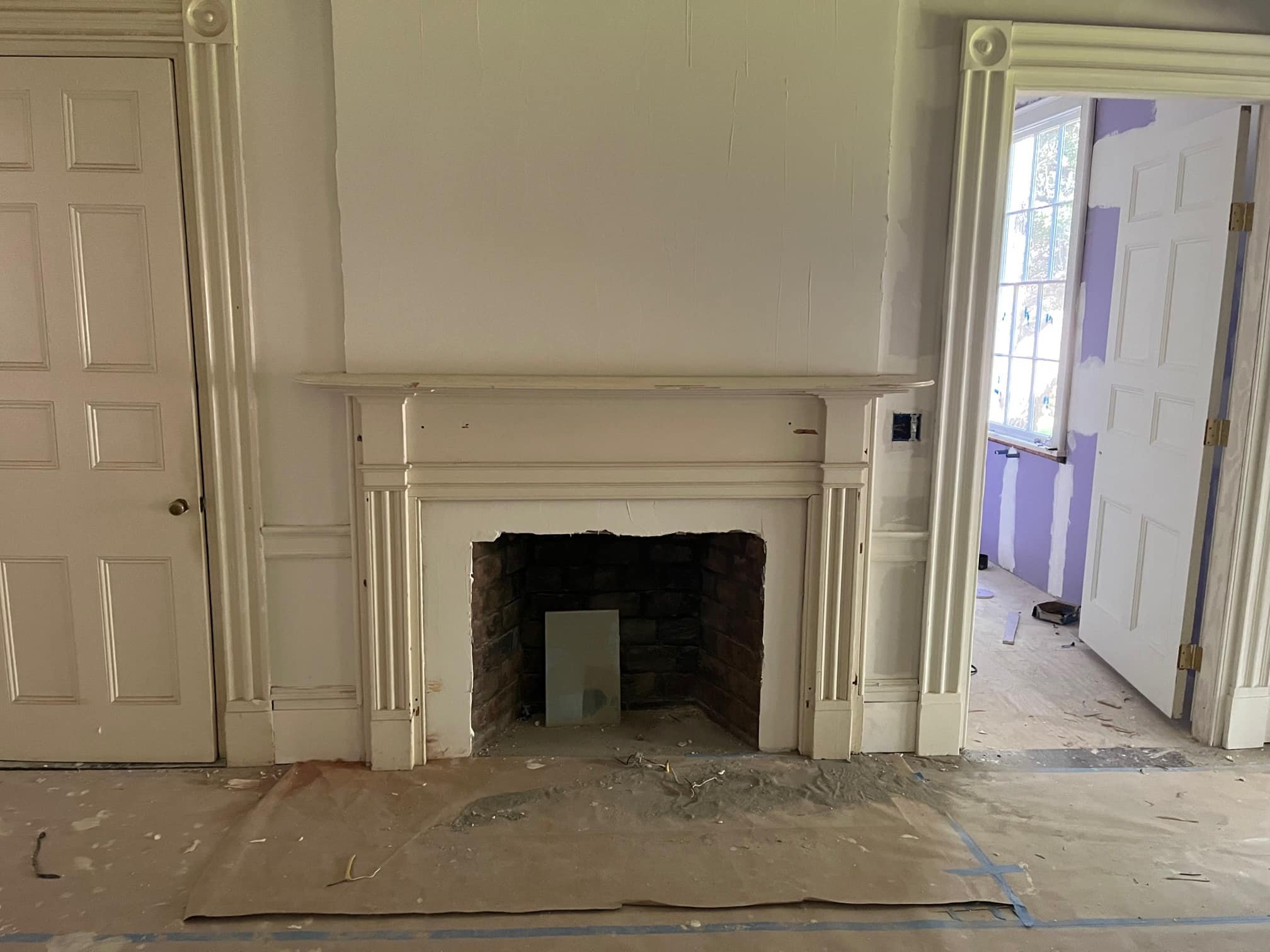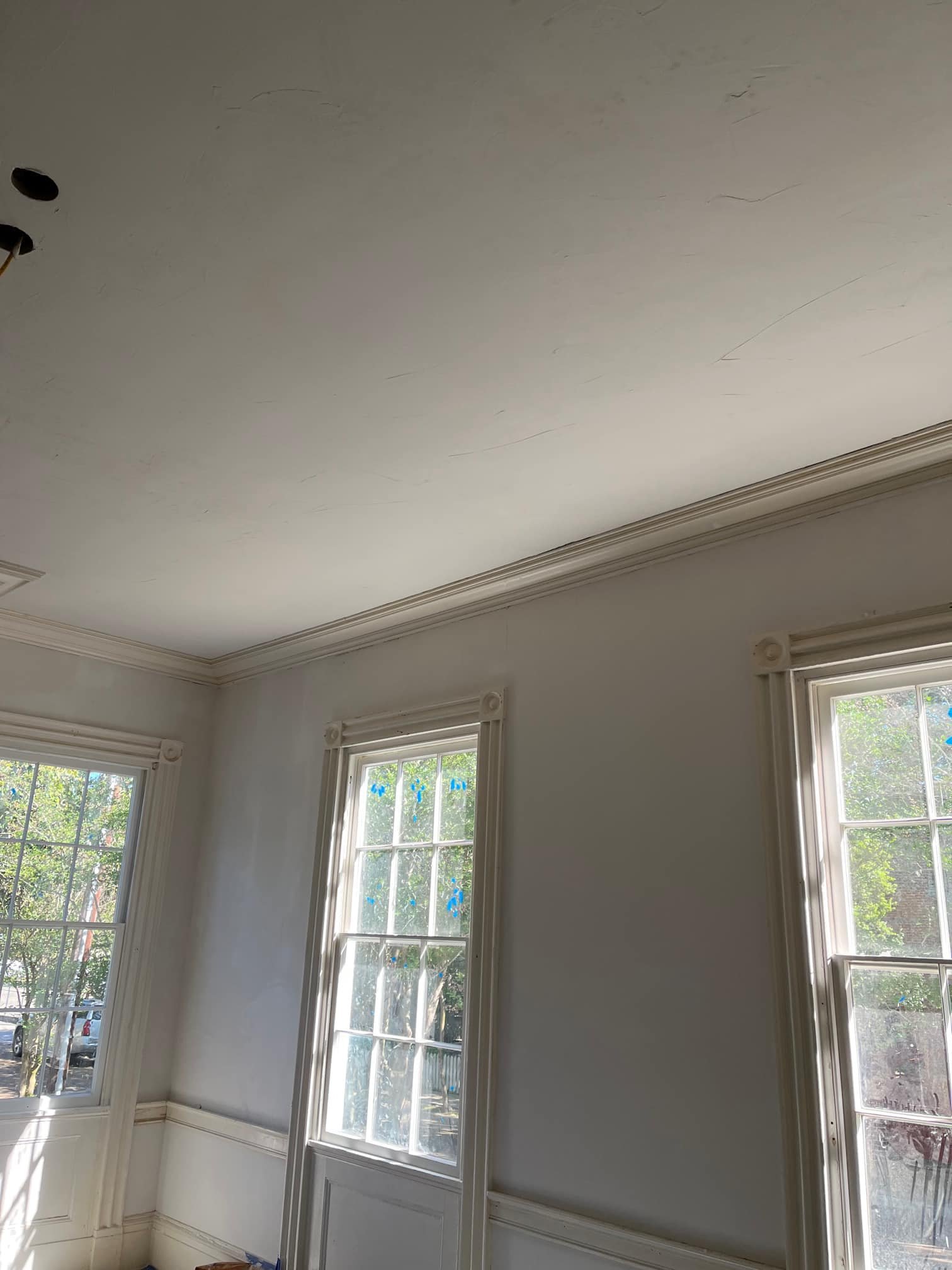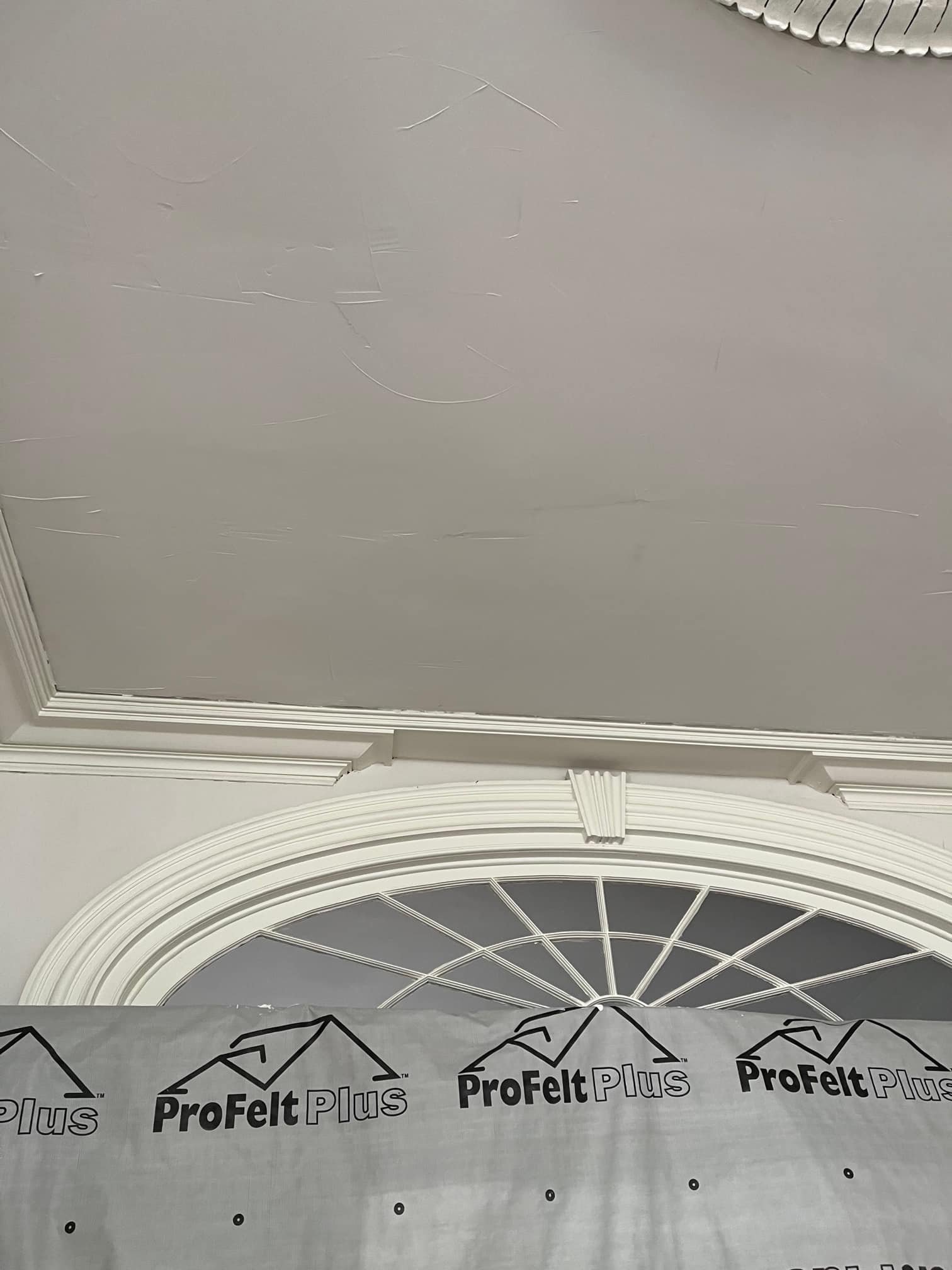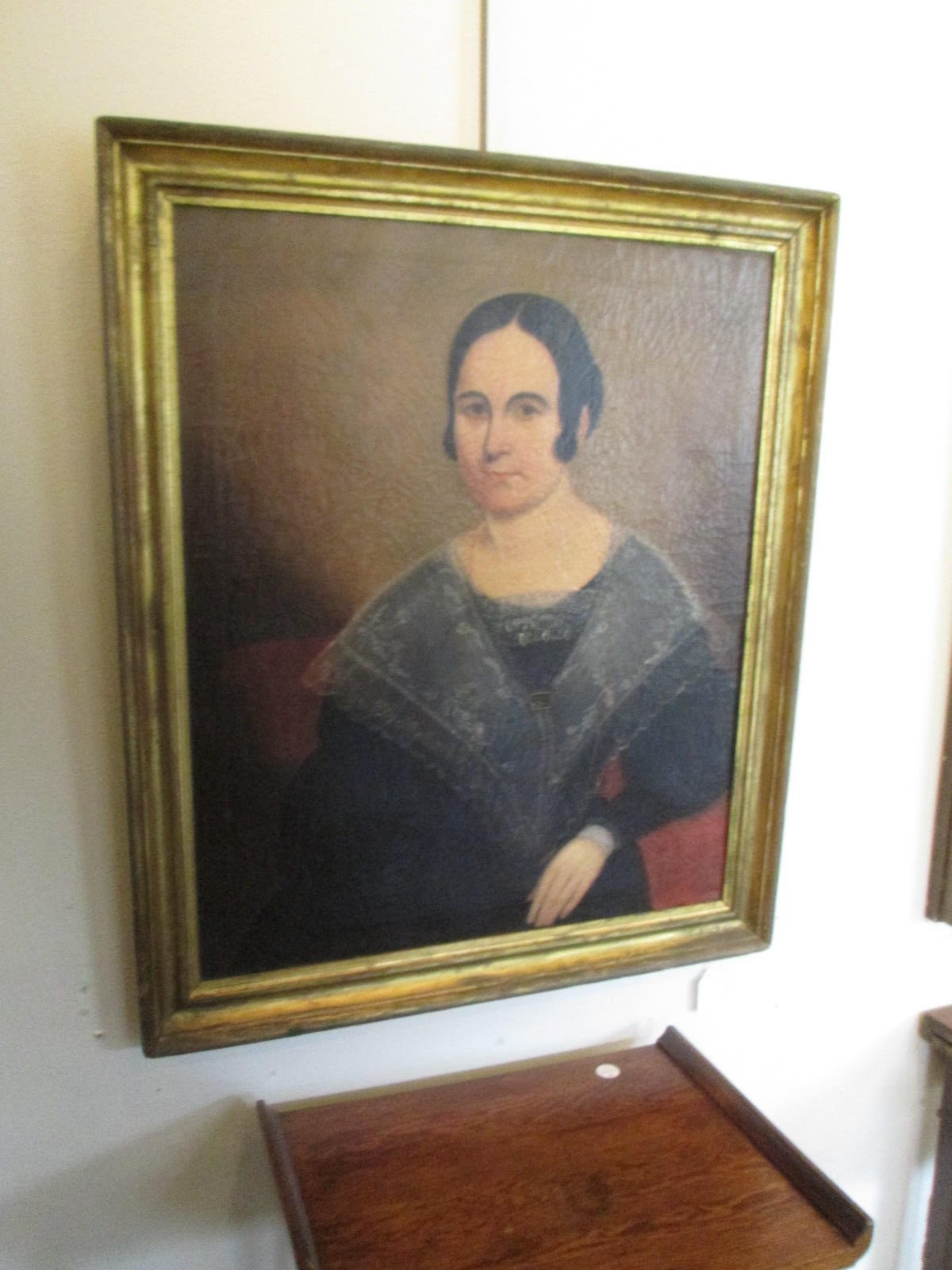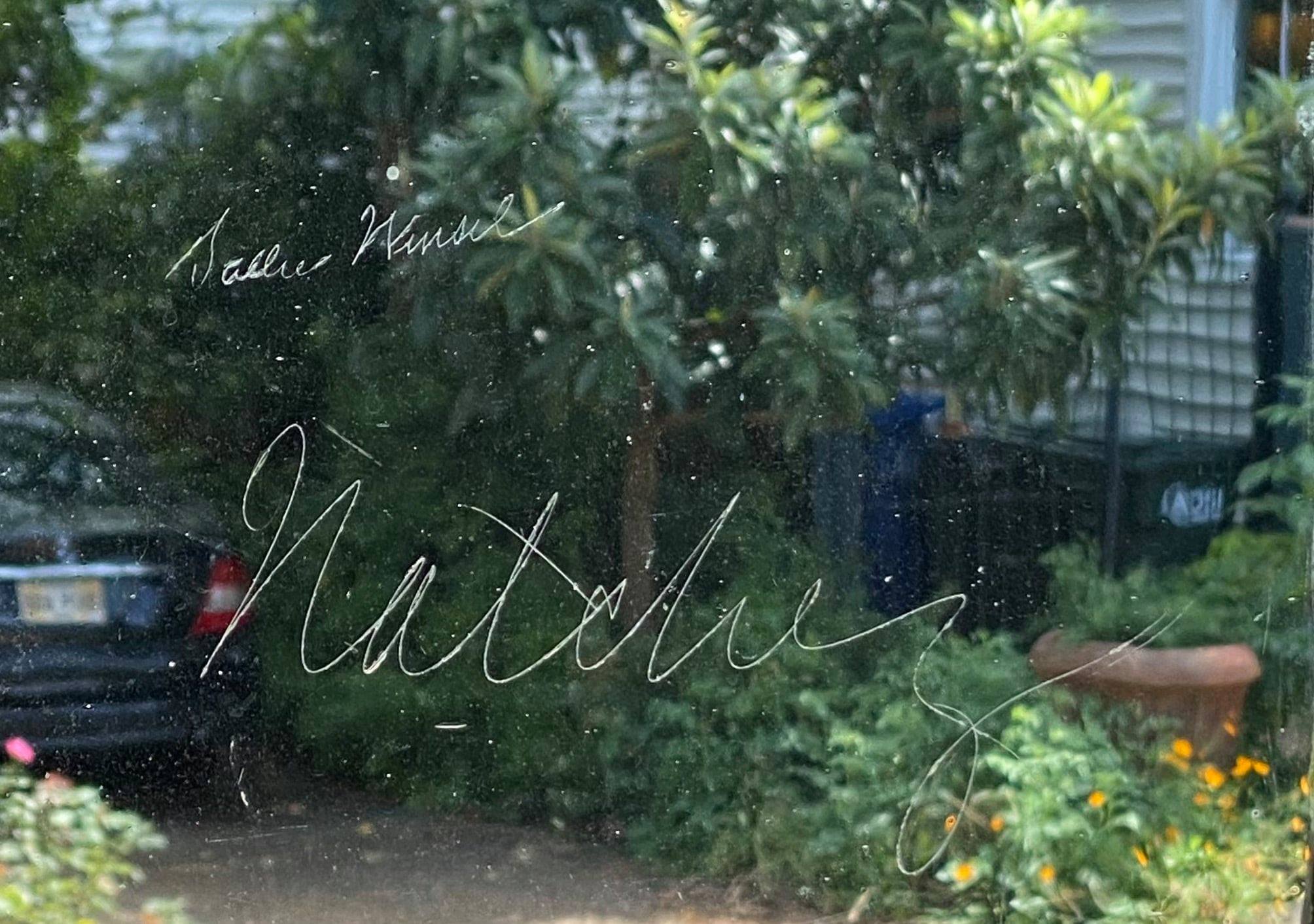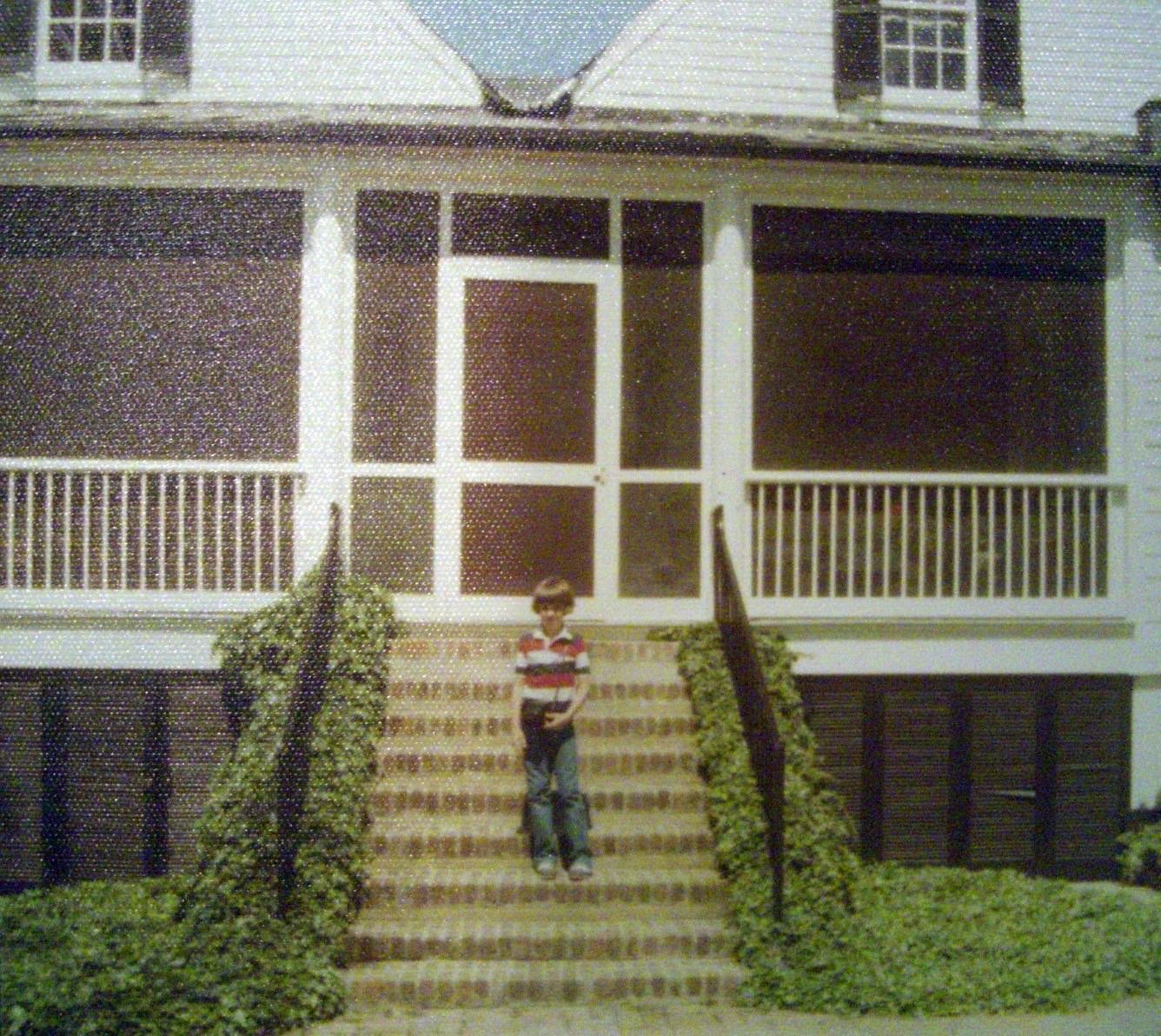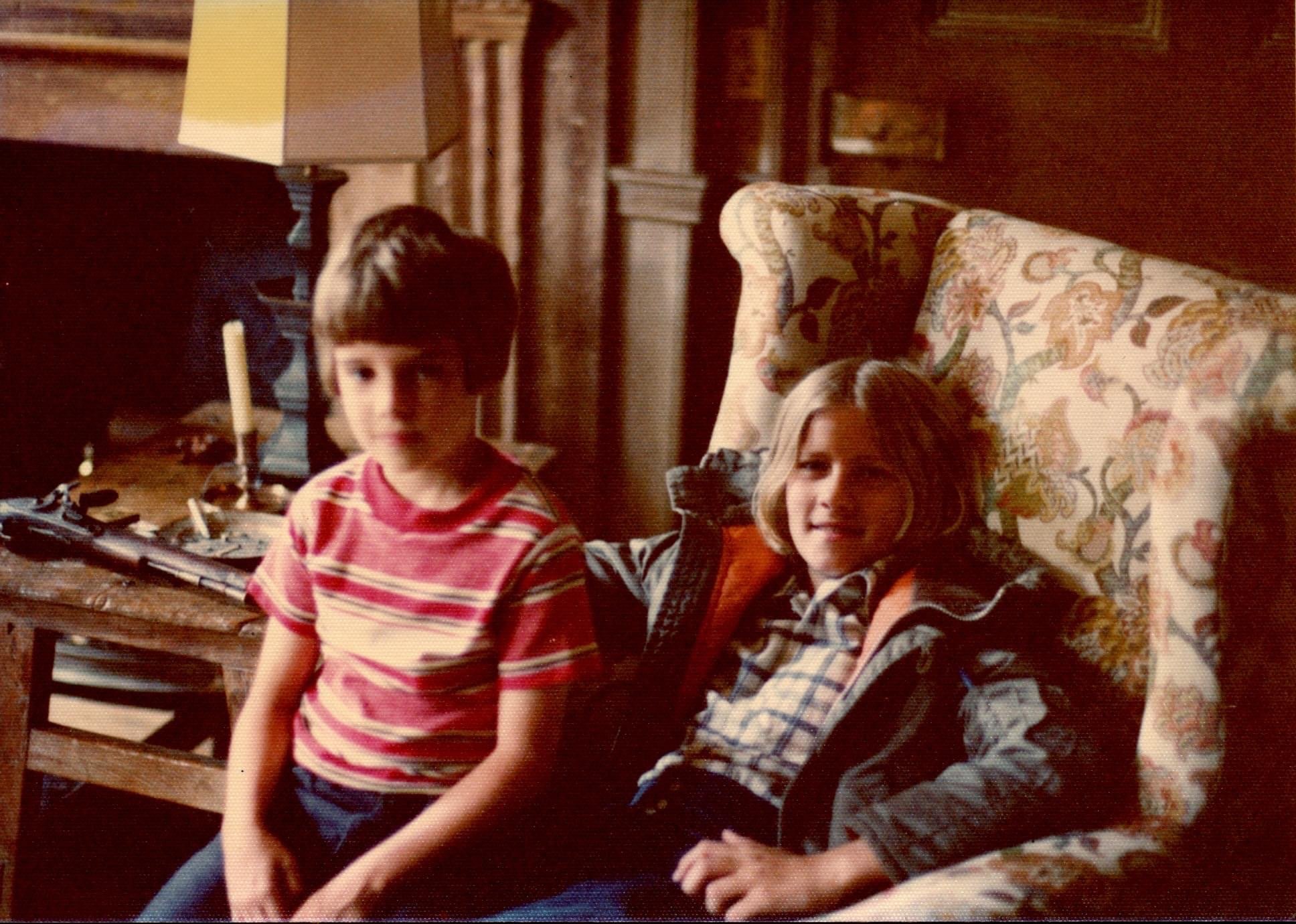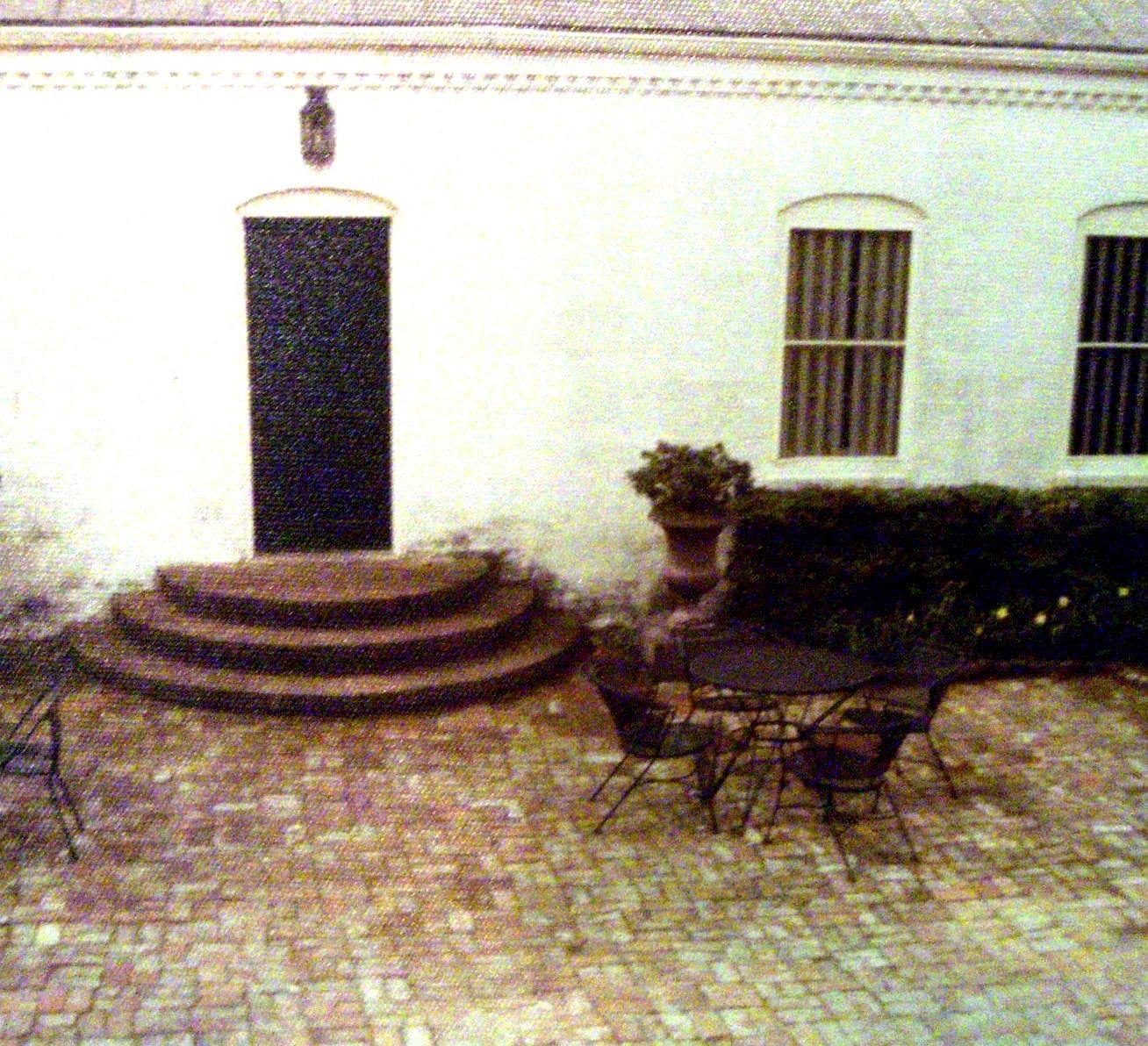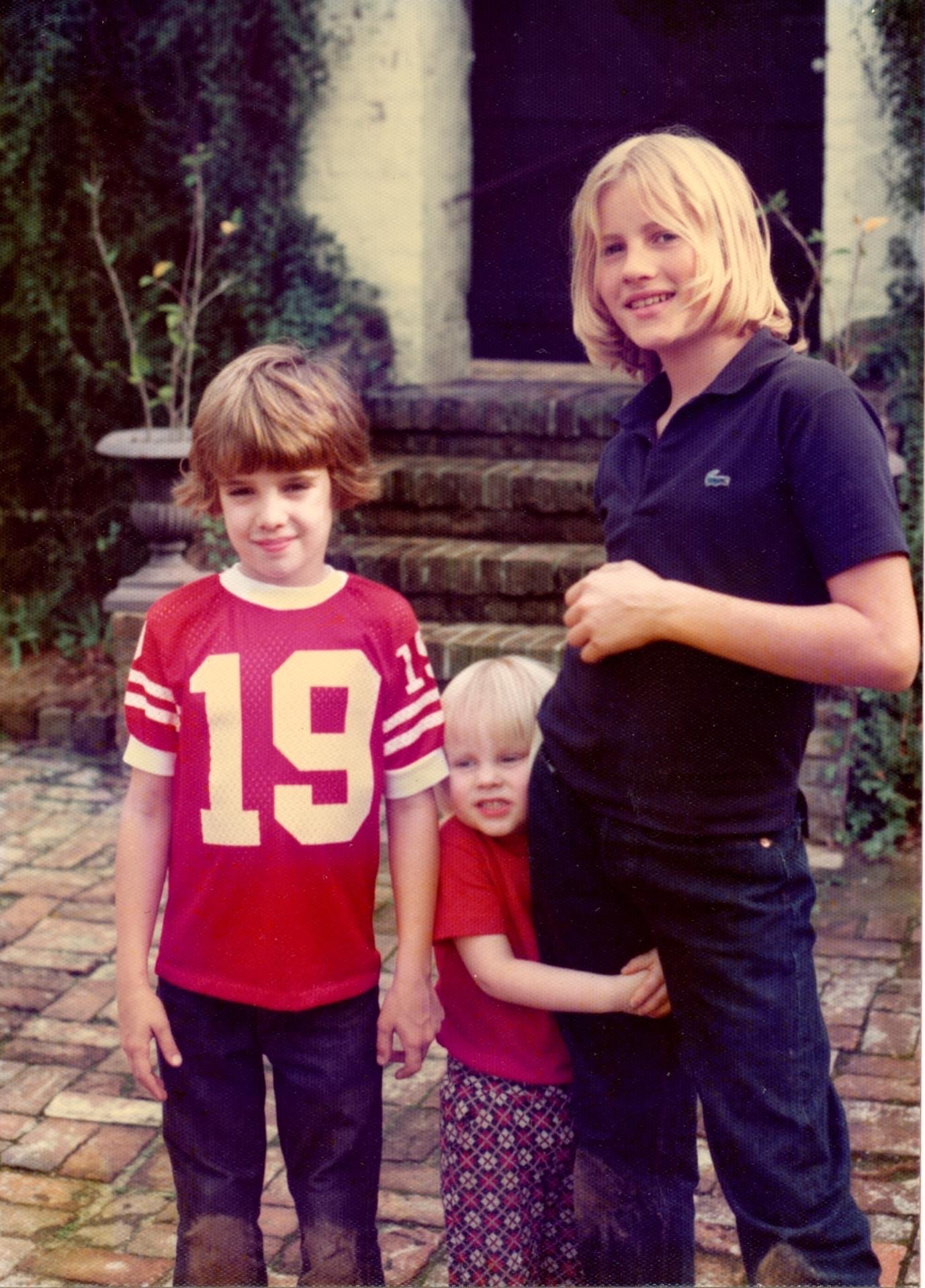Holly Hedges Natchez, MS
Spring Pilgrimage 2024
HOLLY HEDGES 1796
Located at one of the most historically significant intersections in the Natchez area during Spain’s occupation of Natchez from 1783-1798 sets this charming home, known today as Holly Hedges.
Although its earliest history dates to 1796 when a structure was built by Mr. John Scott, who received a Spanish grant on what was known as Block 1; it is believed Holly Hedges took its current form by 1805 when his widow, Susanna petitioned for a deed to the lot where the home she was building (or remodeling)sits today.
Of great significance in the chain of ownership of Holly Hedges is the tenure of the John T. McMurran family who lived here until their massive suburban estates Melrose was completed in 1848. Melrose is today the crown jewel of The Natchez National Historical Park.
Still later, Holly Hedges became the Natchez home of celebrated Dallas interior designer Earl Hart Miller and his wife Zan, who in 1948 completely restored the Federal era home and added the interlaced Federal style dormers and celebrated parterre garden to the original home giving it added visual appeal and gave the home the name Holly Hedges.
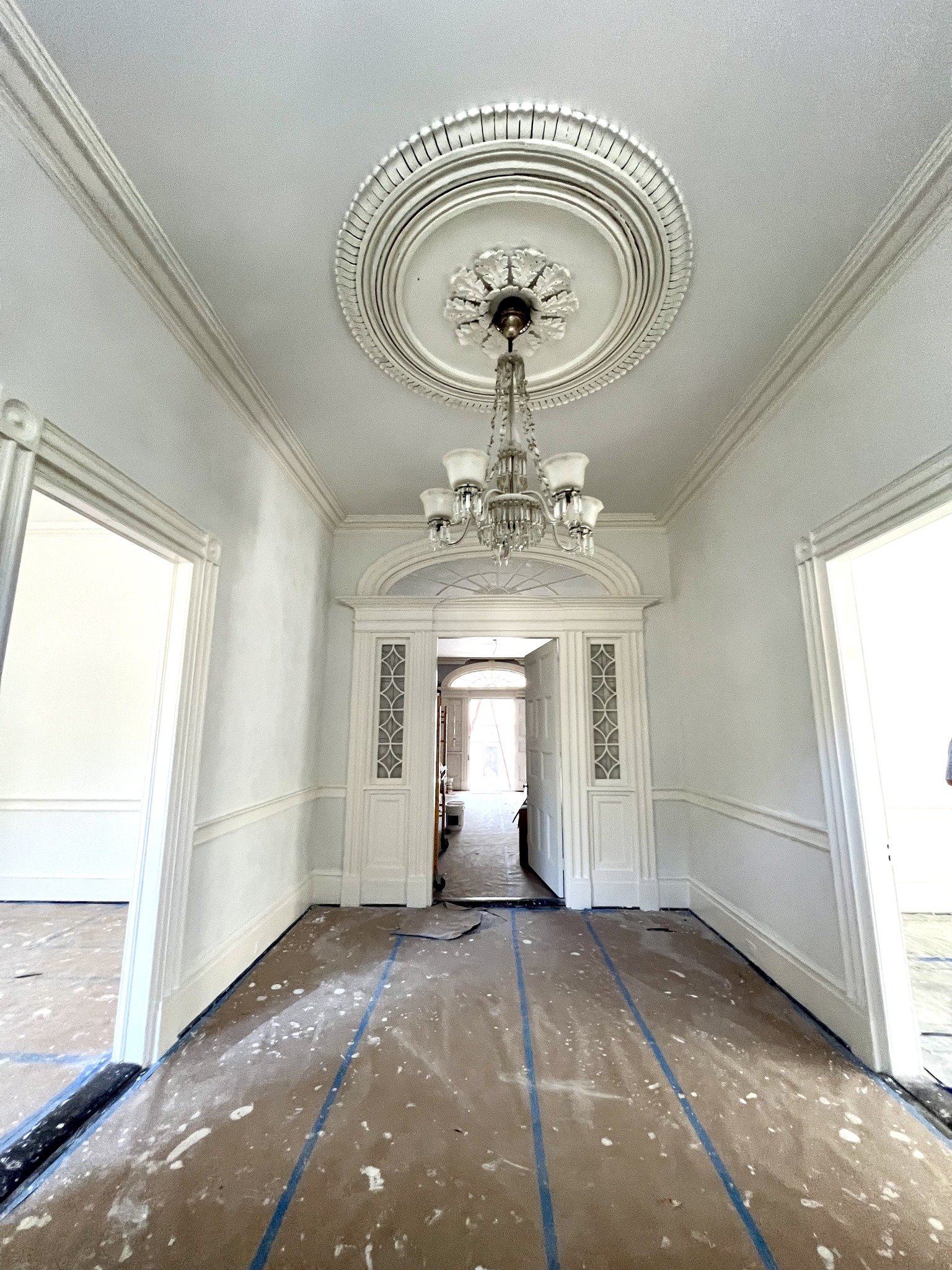

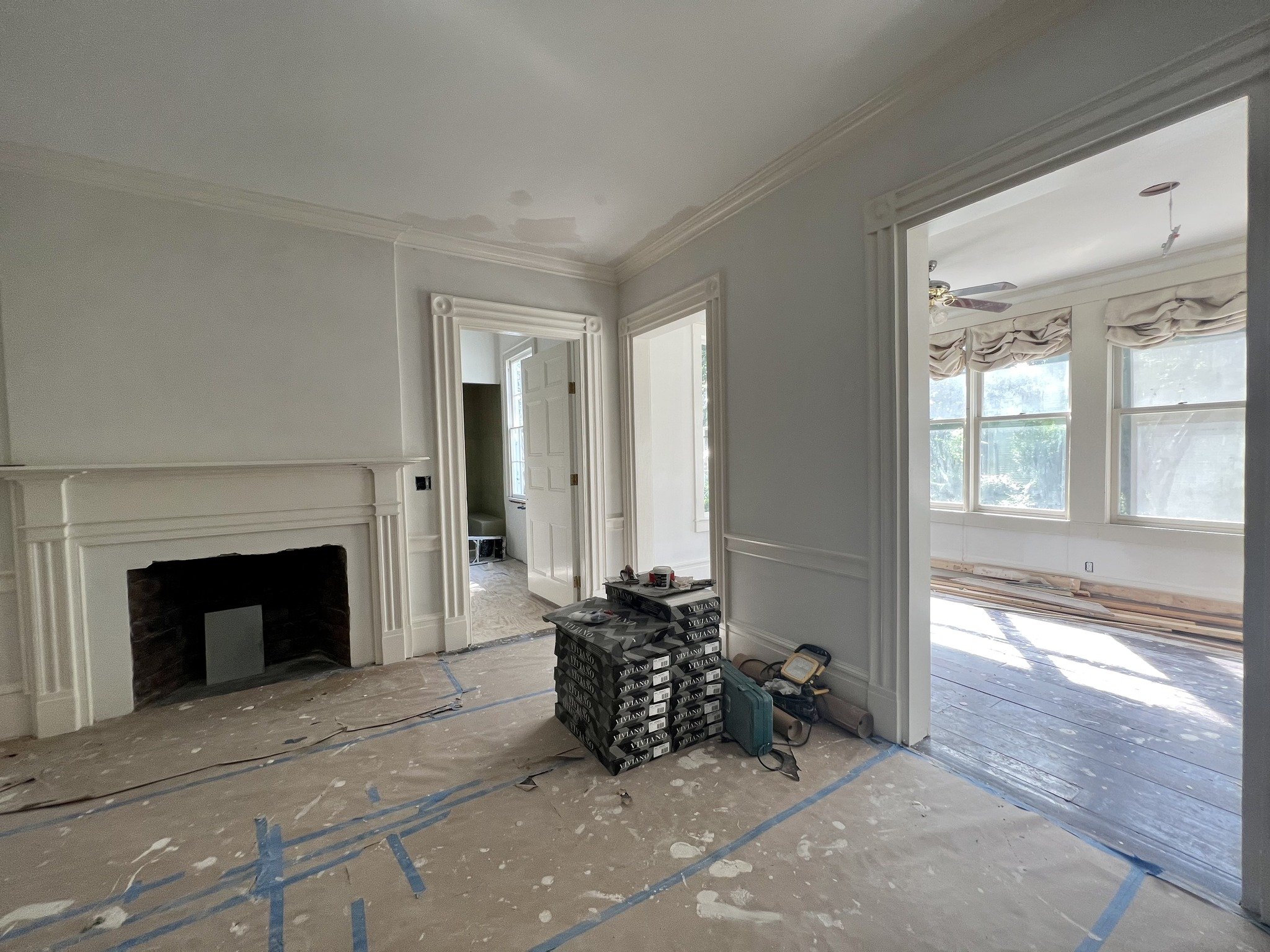
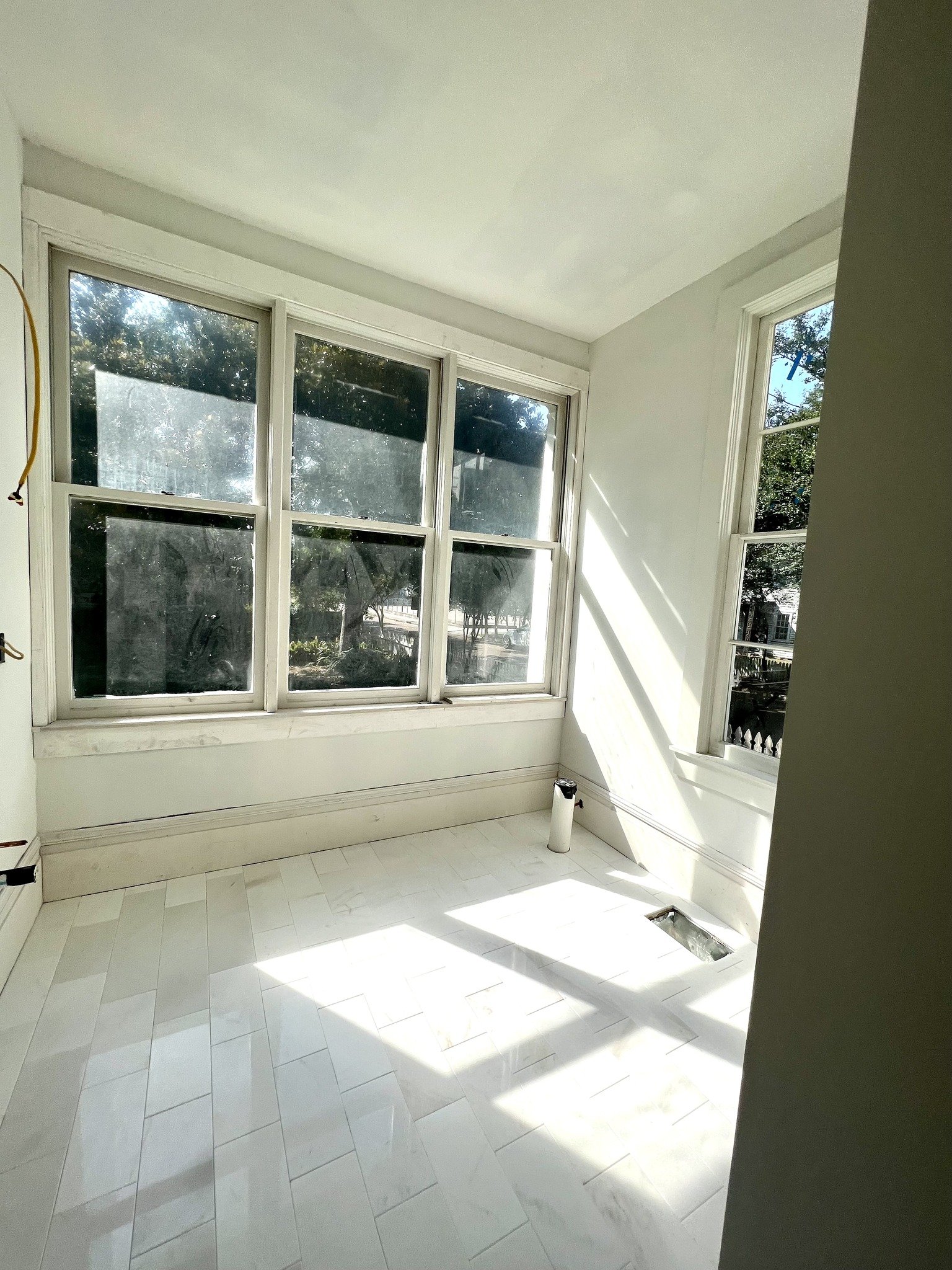
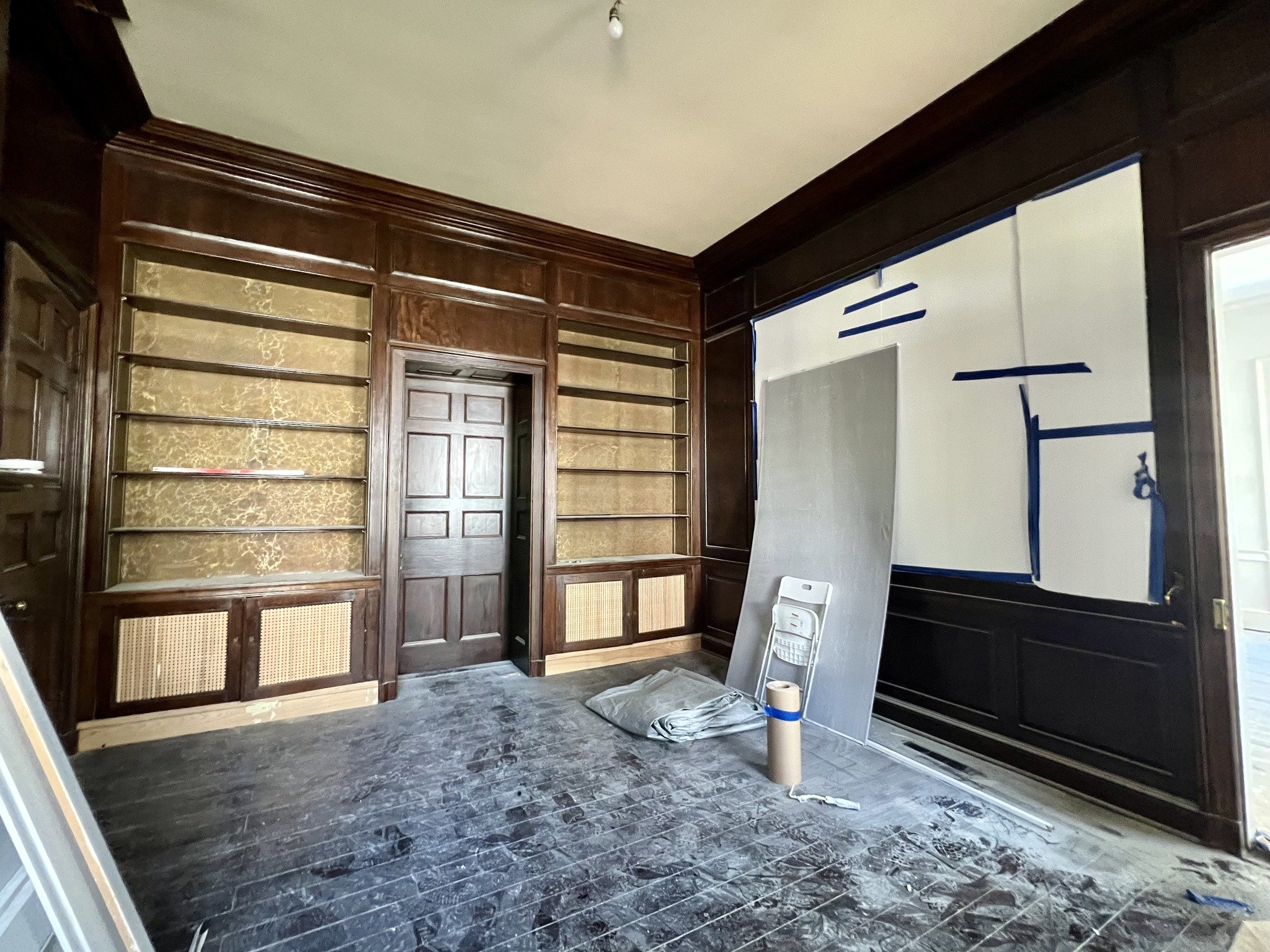
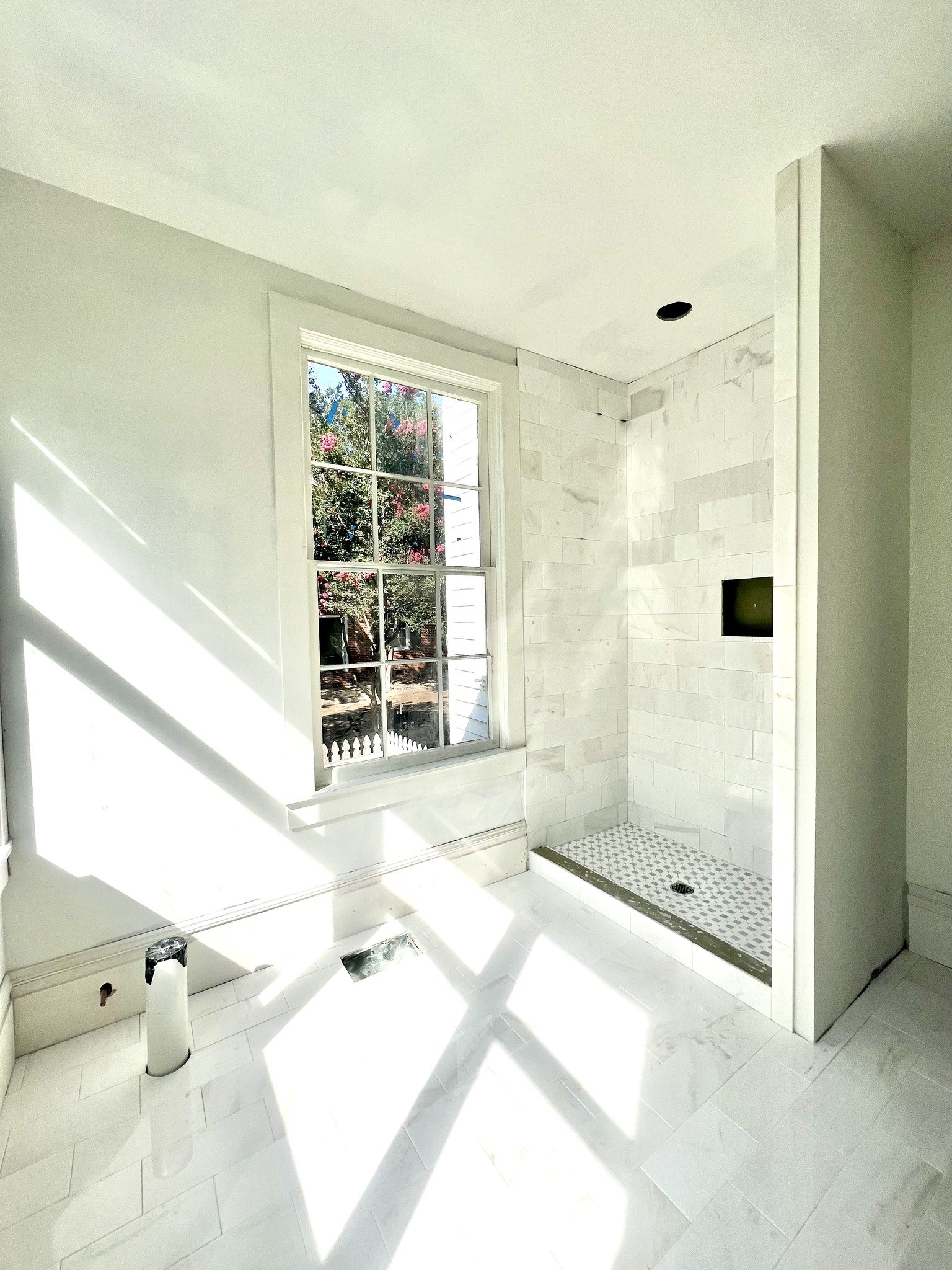
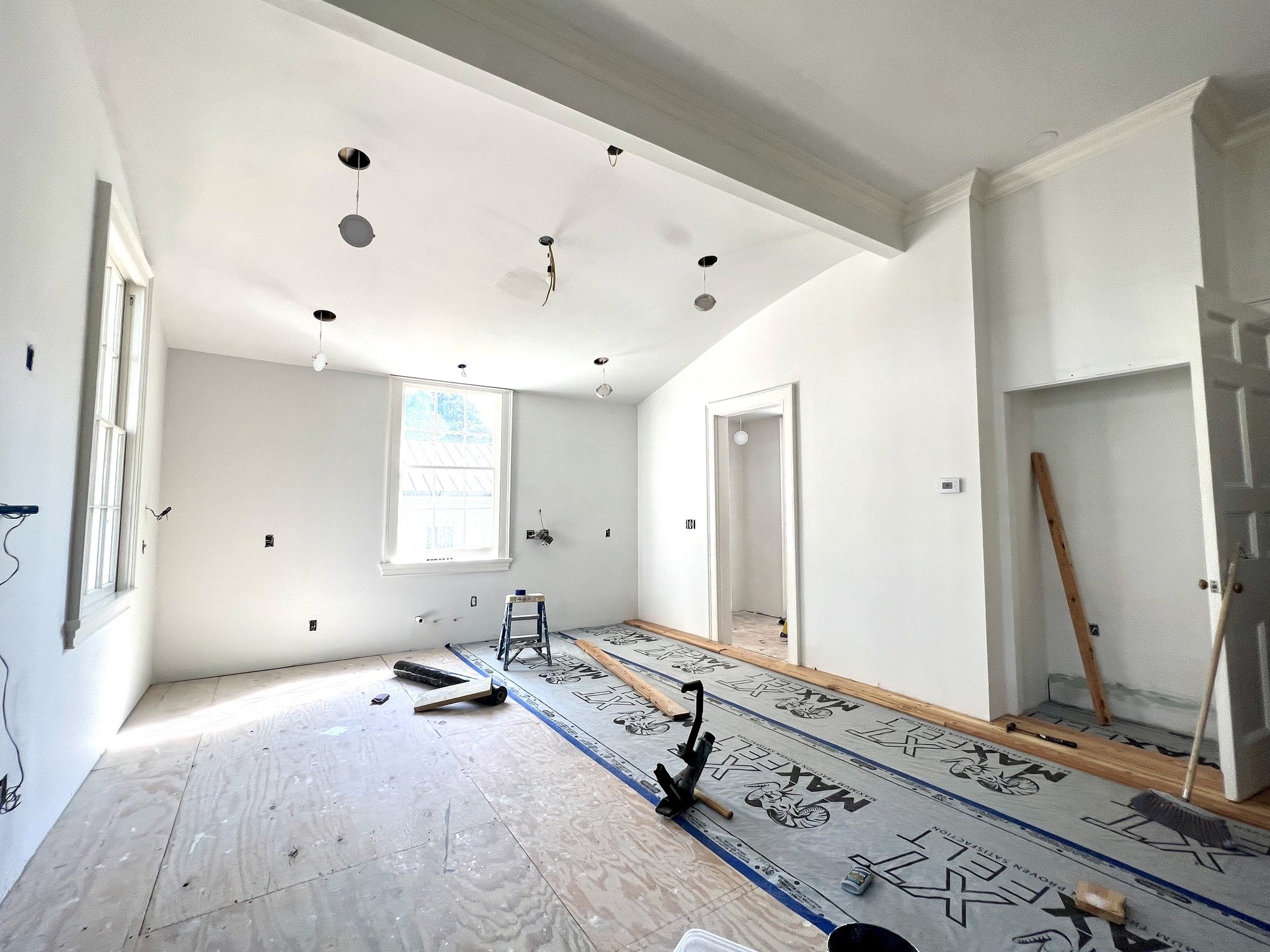

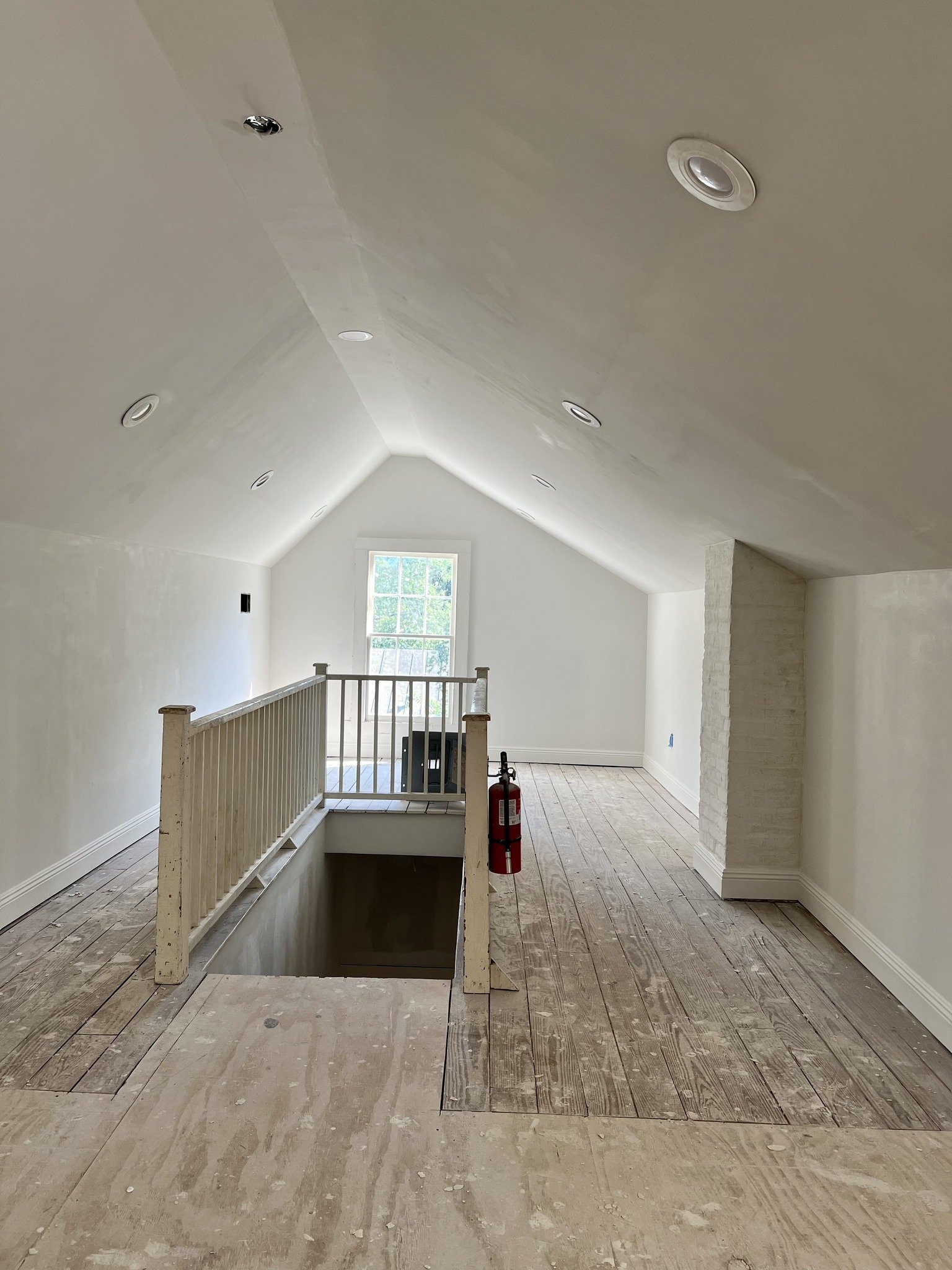
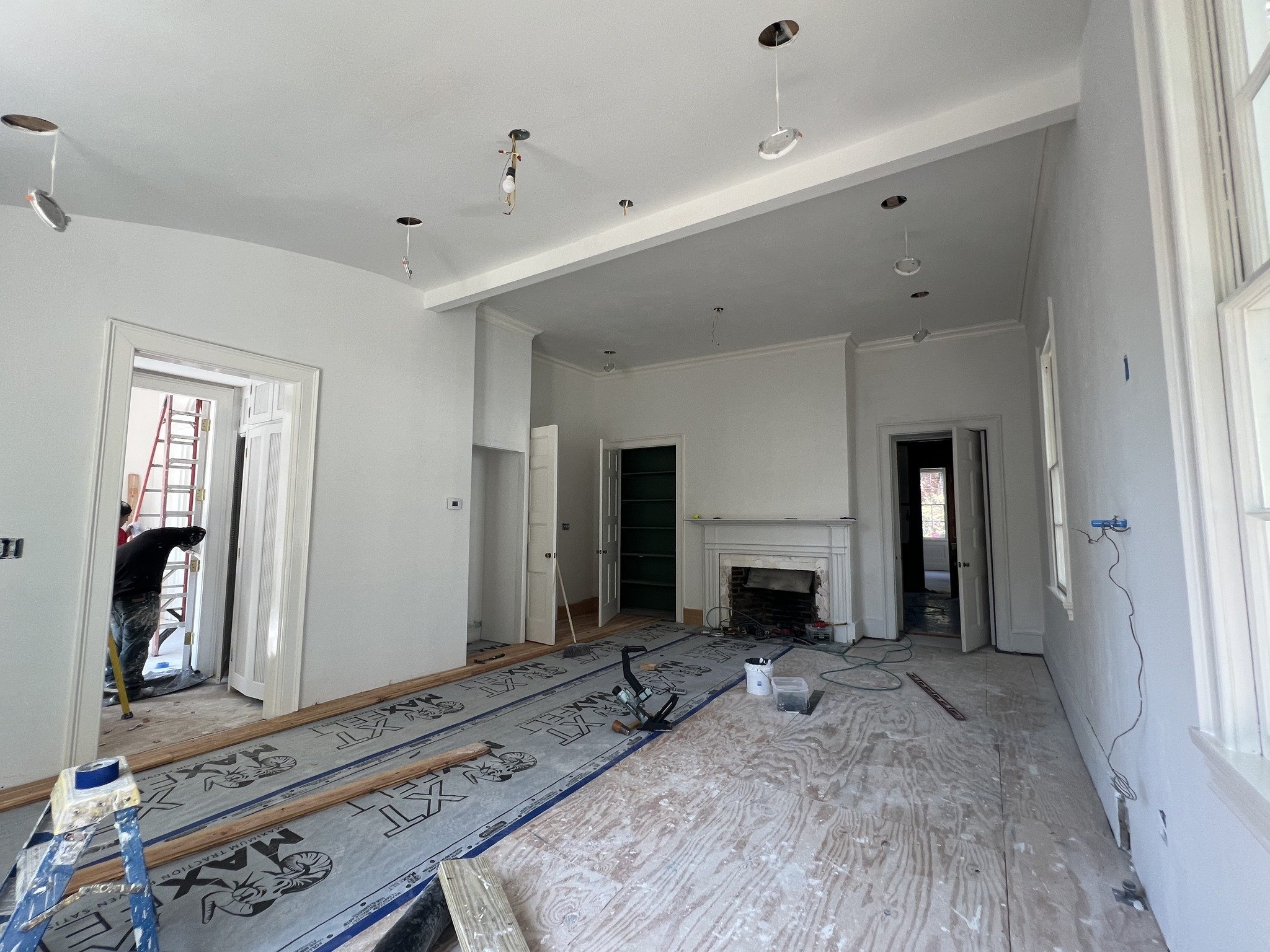

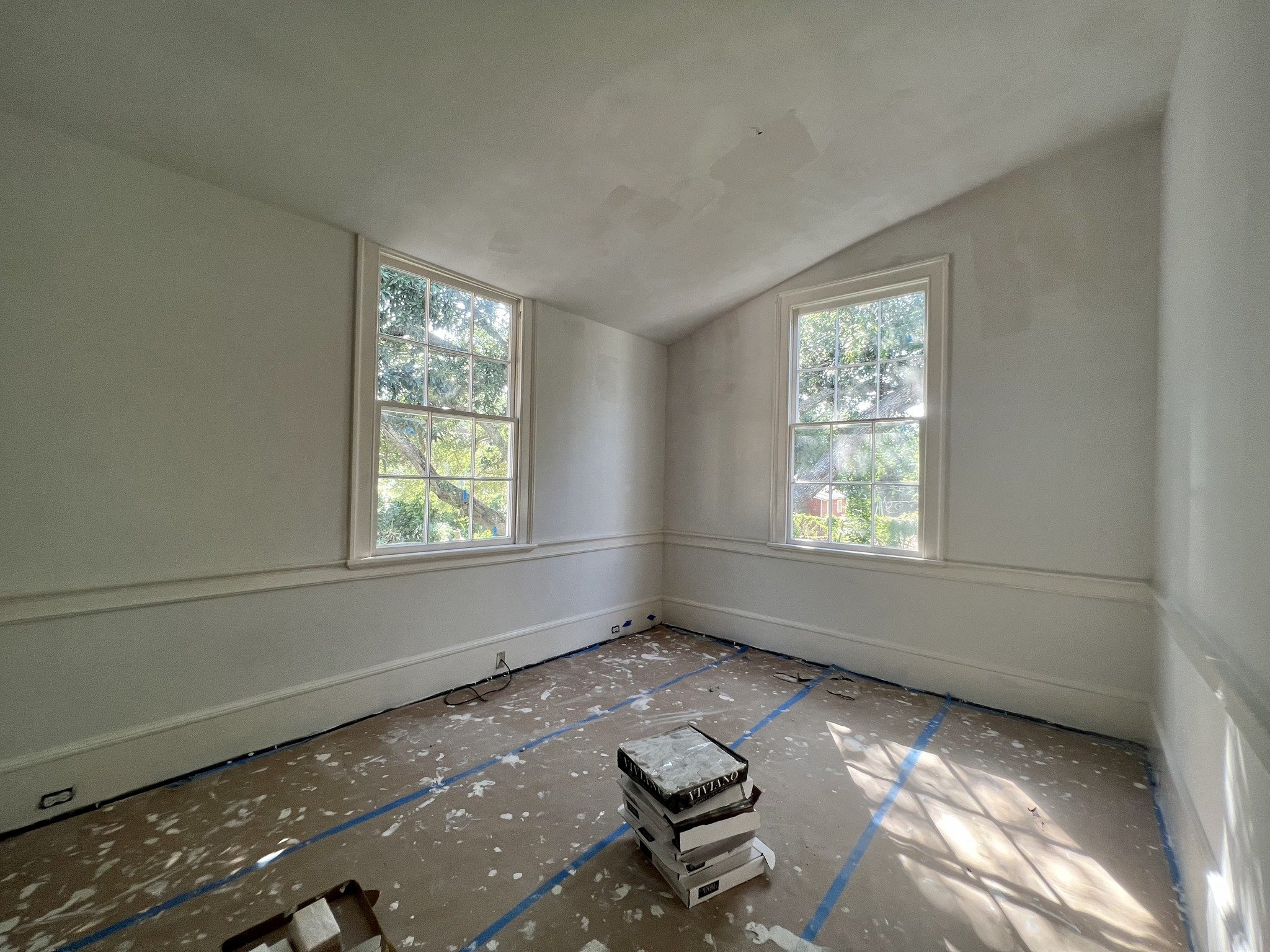
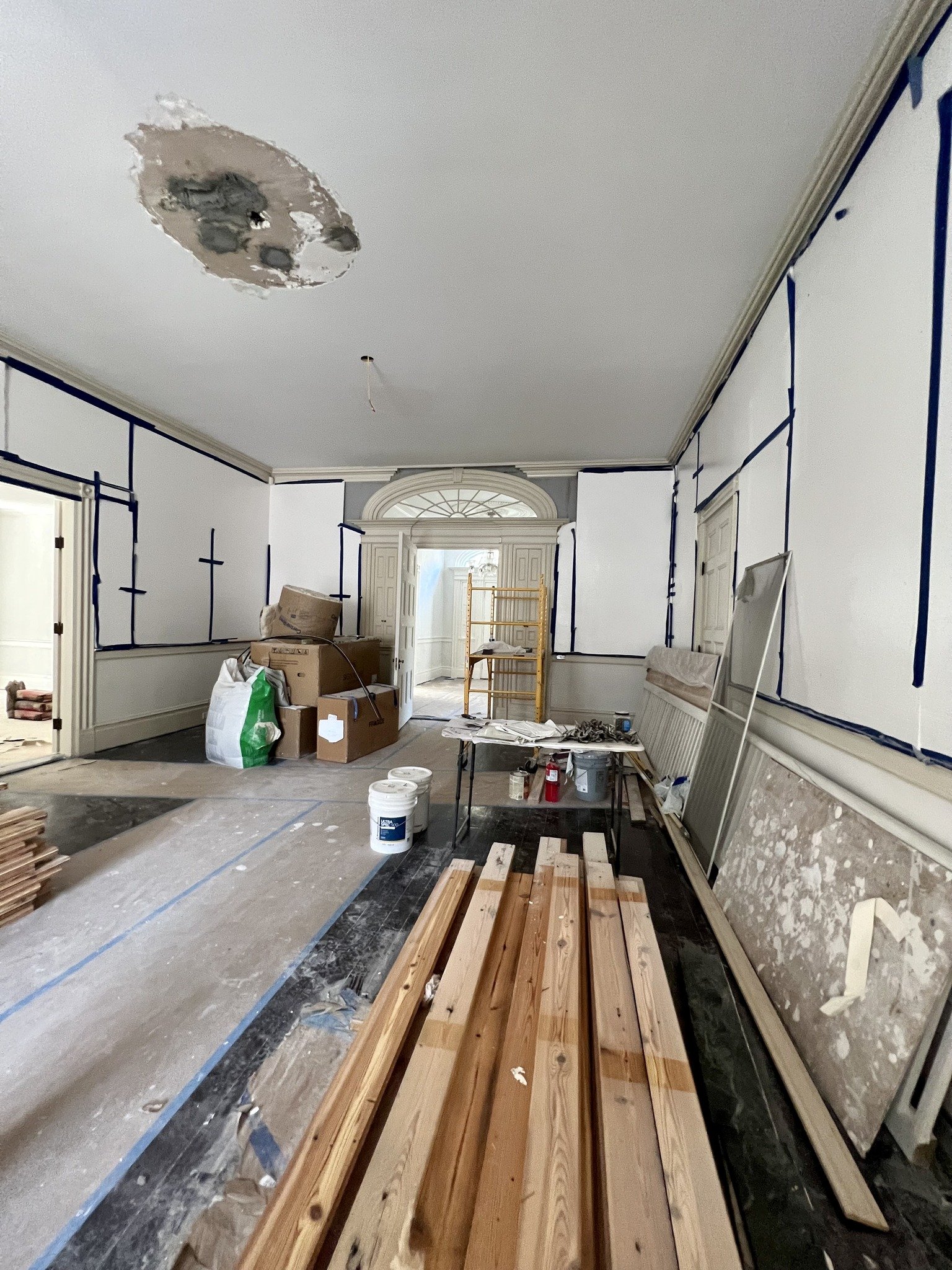
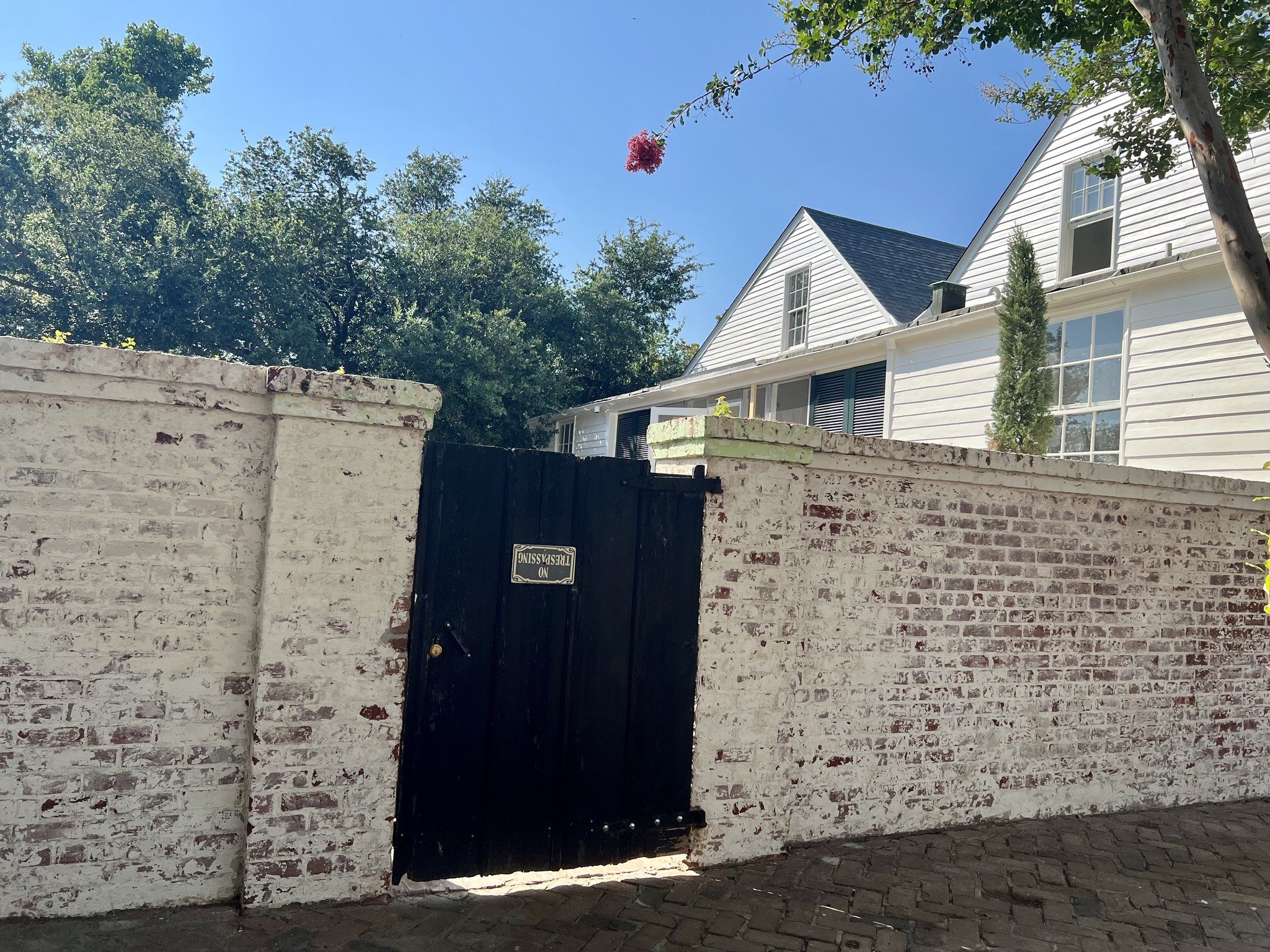

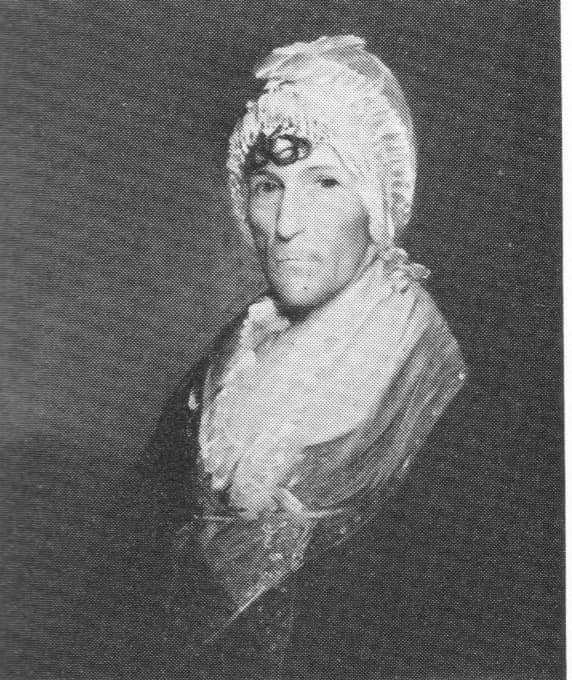
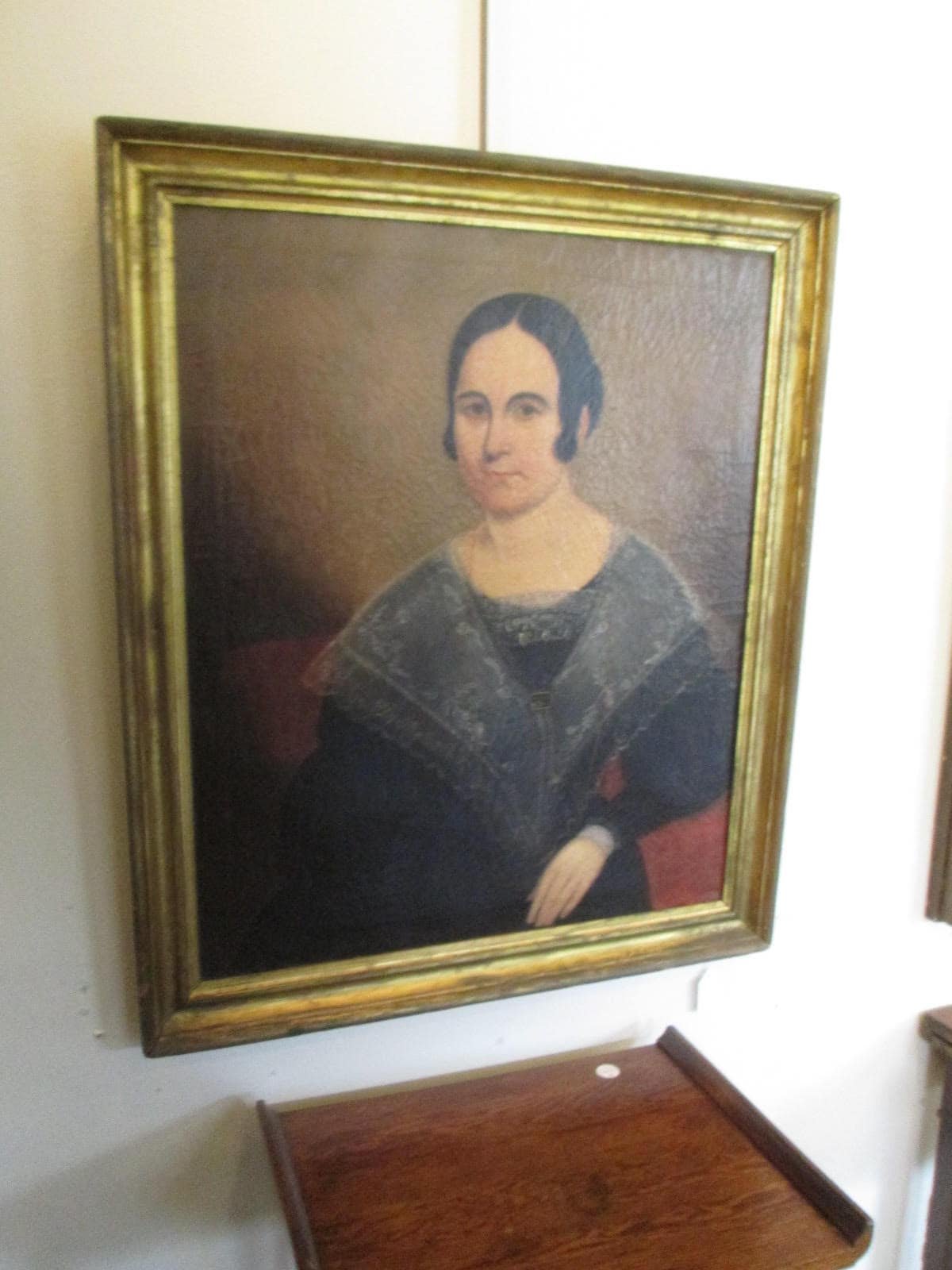
July Update!
The progress at Holly Hedges continues! Updated photos! We are HOPING to be complete around November. It would be sooner but all the cabinets throughout the home (kitchen and baths) needed to be completely rebuilt (nothing left was original and all were in poor condition.)
The walls have all been smoothed to a beautiful Level 5 texture and the woodwork has been painted in most of the rooms. The floors in the beautiful new kitchen are being laid so the kitchen cabinets can be installed on July 10.
Tile work is being done in ALL bathrooms currently and is moving along nicely. There are a lot of moving parts on a job like this and the crew is doing a wonderful job!
*HISTORY UPDATE: I thought I had done all the digging I could on Holly Hedges history, but then out of the blue I’m poking around on the Ancestry site and come across a copy of an oil portrait of Susanna Miller Scott Smith!
Watch the video updates below ↓
April 24th Update!
I’ll show you all of the updates even where the bronze sculpture of Matt, the matador, will go at Holly Hedges … in the middle of the parterre garden!
The property’s original 1796 deed said Don Juan Scott could buy the lot provided there be “no bullfighting in the side yard.” So, of course, we have to put a bullfighter sculpture in the side yard! 😂
UPSTAIRS DESIGN INSPO
The History of Holly Hedges
Where are my history buffs? For 15 days, I'm going to do a post a day about the 15 owners of Holly Hedges, going back to 1796.
Two reasons.
First, I think it's just super interesting to a lot of people.
Second, I know my Natchezian friends are going to come forward with a memory, a story they've heard and... dare I hope... maybe even a photo or two of previous owners and maybe even the home itself.
Why all this obsession with the past? Well as that great Southern writer William Faulkner said, "The past is never dead. It's not even past." I think he was talking about Natchez when he wrote that.
The People of Holly Hedges: Family 1: The Scott Family
OH, the scandals I have just uncovered with Holly Hedge's first family! Or at least some REALLY weird coincidences!
Let's begin at the beginning.
In 1796 Don Juan Scott (Mr. John Scott) "had built" a house on what was laid out by the Spanish Governor as Block 1 of Natchez. He petitioned the governor to receive title to what he had built, and it was granted.... provided there be no bullfighting in the sideyard. (You can't make this stuff up)
John was a builder in Natchez at the time. He was born in Scotland on July 15, 1759, and came to America in 1792.
He married Susanna Miller in Natchez in 1792, and they had two children, Anna Belle Scott and John Turnbull Scott. Some say they were twins, born in 1793, and some say John was born two years later in 1795. Either way, they would have been toddlers when the home was built by 1796.
John has proved to be QUITE an interesting character! Online research shows that he had FIVE children before leaving Scotland and was married to a woman named Margaret Hall. She bore him 5 children (4 girls and a boy) in 14 years (starting when she and John were just 18 years old), and he married her after baby number 3. The records say Margaret had her last baby in 1792.... also the VERY SAME year John married Susanna in America!
Did Margaret die in childbirth in April of 1792 (or he just got tired of her??) and John decided to leave the children behind and haul them straight to America, marrying Susanna soon after arriving? It sure looks that way! 1792 is probably the correct date of their marriage because their daughter Anna Belle (in the portrait) was born in 1793 (though one source says 1794)
John died June 19, 1801, at the age of 41. He wrote a will a few weeks before his death which may suggest illness vs. sudden death or accident. He was buried at Routh Cemetery in Natchez. Susanna was the stepdaughter of Marcus Eiler who owned Routh Cemetery in 1801, which is surely why John is buried there.
Susanna was born in 1772 so she would have been 29 when her husband died, and her children would have been 8 and 6 (or both 8 if the twin part is true.)
In 1805 records indicate that Susanna, "the widow of John Scott," was building a house where Holly Hedges is and petitioned for title. What we DON'T know is whether she was adding onto the house built in 1796 or did she tear that one down and start from scratch?
She married her second husband, Philander Smith (in the portrait), sometime between 1805 and 1811. By 1805 she had been a widow for 4 years and would be 33 years old. Was she about to marry Philander... is that how she had the money to build/add onto the house?
The BIGGEST mystery is Philander's supposed EIGHTH child, named Philander A Smith. He was born in 1817. Records say his mother was Esther but she died in 1801. In 1817 Philander was already married for years to Susanna who would have been 45 years old! Is there ANY way a 45-year-old woman would have been able to give birth? 24 years after she had last given birth? Was there a mistress involved?
After I first posted this I came across Philander's will and he specifically names ALL his children and there was no Philander A mentioned. Due to the dates, I do believe it was a grandson but haven't yet been able to prove it.
Additional Fun Facts:
In 1807 Philander Smith was the foreman on the grand jury that acquitted Aaron Burr of conspiracy charges in a trial held just outside of Natchez. If walls could talk, I wish they would tell all the stories that Philander must have told of the Burr treason trial.
I found (and ordered a copy of) a letter (written April of 1811) from Philander to his brother in Massachusetts complaining of trade embargoes and politics and telling his brother that his wife is his second wife (his first wife Esther died in 1801 at age 35) but that she is "a good mother to his children." He had SEVEN children with Esther before she died. Depending on how old they were when he married Susanna, presumably at least some of these would have lived at Holly Hedges with Susanna's two children. SURELY they were using that upper floor space!
Bizarrely, Anna Belle, Susanna's daughter shown in the portrait, actually married her stepbrother Benjamin (son of Philander). Those were different times, I guess!
Philander died in 1824 and Susanna in 1838. After Philander died, Susanna lived with her daughter Anna Belle at Island Plantation near St. Francisville, LA and they are all buried nearby.
I actually found a descendant of John Scott, living in Natchez, thanks to Ancestry. She's the one who added John Scott's grave marker photo to Ancestry. I reached out and she had NO idea that he built Holly Hedges. We are going to connect and tour the place next time I'm in town.
Still on my list to do (just regarding this one family):
I believe Routh Cemetery is a private cemetery so if any of you know how I can access it on a future visit that would be great.
I need to go to the cemetery near St. Francisville to see the graves of the other family members.
I need to find a copy of the 1796 deed prohibiting bullfighting AND I need John Scott's 1801 will.
A trip to the courthouse is in order!
The People of Holly Hedges: Family 2: The Turner Family
In 1818 Holly Hedges, as it is known today, was sold by its owners Susanna Scott Smith and her second husband Philander Smith to Judge Edward Turner and his wife Eliza Baker Turner (Betsy) for $2,000. Philander's will talks about all the funds Susanna had received from her previous marriage plus the growth during her widowhood going to her two children, Anna Belle and John, so I wonder if they gave them the money from this sale? I believe they did.
About a year later the Turners also purchased Texada Tavern across the street, the oldest brick home in the area, as a rental property. Their first tenant was the MS state legislature. Apparently there is some growing evidence that John James Audubon stayed there for a time when he was in the area (his painting of Natchez was 1823 so I'm supposing it would have been at that time, while the Turners owned it.)
The Turners were a very interesting and well-known family at the time. Recently I have posted the two portraits I had run across to date (with help from the Historic Natchez Foundation) along with a silhouette from a museum in New Orleans.
Carter Burns and Mimi Miller mentioned that there are thought to be three portraits of the Turners, and I MAY have just run across the third on the Ancestry site! (It's the first photo attached) I've reached out to the lady who posted the photo and hope to hear back as to where the portrait hangs currently.
Here's a bit more about the illustrious Judge Turner and his wife Betsy:
Edward Turner was born in Fairfax County, VA in Nov. 25, 1778. He was educated at Transylvania University in Kentucky, where he studied law. In 1801 he moved to Natchez where he began practicing law. He was appointed aide-de-camp of the Mississippi Territory and soon became the clerk of the territorial House of Representatives, also serving as the governor’s private secretary.
He was elected to the Mississippi legislature (twice serving as Speaker of the House), and served as Attorney General of Mississippi. He served on the Mississippi Supreme Court, including a time as Chief Justice in 1829 while living at Holly Hedges. That's quite a resume!!
Sept 5, 1802, he married Mary West and they had two children, who died at ages 6 and 24. SUCH difficult times. Sadly his young wife Mary West Turner also died in 1811 at the age of 25.
Edward then married Eliza (Betsy) Baker (1789-1878) from New Jersey on Dec. 26, 1812. They had two daughters Mary Louisa Turner (McMurran) and Elizabeth Frances Turner -known as Fanny (Conner.) He also had two sons, John and Edward, but both died around age 4.
He was described as a portly and commanding figure, standing 6’ 2”. He was said to be generous and kind, brilliant in conversation, and gracious in manners. I always read that he was not considered a “profound lawyer” but he was thoroughly honest and industrious and is considered the great judicial figure of the early period of Mississippi. I wonder why they always have to throw shade that he wasn't profound. Who needs profundity?
I have seen it questioned whether Judge Turner built a new home on the spot or remodeled the home ... but I don't think so... I think he bought it as it stood and here is why. Susanna had been building a house on the spot in 1805 ...which I personally also believe was also adding onto the original 1796 structure... but can't prove it.
I could be wrong, but I just don't picture those early territorial days being quite flush enough with cash that they would tear down anything of value. I would think they would add to what was there. The first owner John Scott was known as a builder so I personally like to assume that his starter home was at least decent quality and not just kindling. It's not like someone like me built the home, cobbling together some sticks. John Scott was a proper builder.
Then Susanna was also building on the site in 1805 and later married Philander Smith, a man of some note. I can't picture what any of these people had built to be so shoddy that Judge Turner would have torn it down. I mean, who has the time? He also bought Texada across the street which was also already a fully formed house.
Natchez history is blessed by the existence or so many portraits and paintings because there was SO much wealth there at the in the decades before the Civil War. That would have made it a very attractive destination for portrait artists seeking multiple commissions, right?
In 1823 John James Audubon spent some time in the area and painted a well known portrait of Natchez, in which you can see Holly Hedges as a single gabled building. It's certainly not so grand that it makes me think Judge Turner's predecessors couldn't have built it before his acquisition in 1818 (see the close up). In 1835 Tooley painted a very similarly angled portrait and we will see tomorrow that between 1823 and 1835 an obvious and significant addition had been done, putting the home into basically the foot print we have today. So stay tuned!
After a long and well lived life Judge Turner died May 23, 1860... shortly before the start of the Civil War... in Natchez at his then home, The Woodlands. He was 81. His wife Betsy lived on at The Woodlands until her death in 1878 at the ripe old age of 89. They both lived a very long life for those times!
He and Betsy had lived in Holly Hedges from 1818 to 1832 at which time they gave the property to their older daughter Mary as a wedding gift. But that is tomorrow's story!
The People of Holly Hedges: Family 3: The McMurran Family
The McMurrans honestly deserve their own book, so I'll have to make special efforts to abbreviate! They had an exceptional life but also one plagued by loss. They are among the best known Natchez Nabobs... as the high society planter class were sometimes called. The built Melrose, one of the largest, most beautiful homes in Natchez in 1848, originally on 133 acres.
The home is so important historically that it was acquired in 1990 by the National Park Service and is operated as a tour home by the Park Service even now. One thing that made the home so important was that the McMurrans sold it almost completely in tact with nearly all its furnishings in 1865 at the end of the war when they, like others, simply could no longer afford it.
So the property stood as a time capsule to opulence and wealth, and of course the slave economy which had helped to create it.
John Thompson McMurran was born in Pennsylvania (like so many Natchez planters) in 1801. He studied law with an uncle in Ohio and moved to Natchez to seek his fortune in 1825. In 1831 he married Mary Louisa Turner, daughter of Judge Edward Turner (of yesterday's history post.) The Turners were a family of means and gave the young couple Holly Hedges as a wedding present.
It makes sense to me that the McMurrans are the ones (possibly with help from the Turners) who enlarged Holly Hedges by adding the two wings to the back. Yesterday's post showed the home as a single gabled house in the 1823 painting by Audubon. The 1835 Tooley painting shows both wings were in place, giving it the footprint we know today. During this time servant's quarters were added as a separate building as you can see. This building appeared on Sanborn Fire Insurance maps as late as 1901 but were gone by the time the 1904 maps were created.
The McMurrans had three children. The first daughter, a honeymoon baby, died before her second birthday. They had a son John T. McMurran, Jr. and a daughter Mary Elizabeth McMurran Conner.
John, Jr. served in the Civil War briefly but was discharged due to hearing loss. He was something of a ne'er do well anyway so I'm wondering if he was exaggerating! His wife Alice bore him four daughters, two of whom lived to adulthood. My mother always said lazy men had daughters (sorry guys) so this is no surprise. BUT he deserted his family (not sure if he officially divorced Alice?) and disappeared up to New York City. In the 1900 census he was married to a Margaret Blake and they had yet another daughter. It said they had been married 25 years which puts their marriage around 1875. His first wife Alice didn't die until 1899!
Their daughter Mary Elizabeth died at age 28 after a long illness that rendered her "child-like." It's thought to have been perhaps Pernicious Anemia or meningitis? She left only one surviving child, Fazee, who had a club foot (operated on in New Orleans) who apparently lived off his grandparents the McMurrans his whole life.
John McMurran the elder was preparing after the war to take his family back north after selling Melrose. However, on his way down to get some papers in order he took the Steamboat Fashion to Baton Rouge I believe. But it exploded and caught fire. He was severely injured trying to jump to shore. They took him down to New Orleans to be treated but he died a couple days later before Mary could get to him. Mary lived on at Woodlands, her parents home, until her death in 1891.
I like to think of Holly Hedges as the McMurran's "starter home" before they built the very grand Melrose. One of General Quitman's daugthers Louisa (a cousin) wrote to her father Gen. Quitman while he was fighting in the Mexican war this letter about a lovely evening spent at Holly Hedges:
"We had a very pleasant party, & the table groaned under the weight of all kinds of ‘good things’ as the children say, when the cloth was removed, the wine produced and the glasses filled, a toast is called for, Mr. McMurran, proposed, “to our absent friends.’ I added ‘in Mexico,’ several others were then given after which we adjourned to the parlour. Cousin Fanny then played upon the piano. I then prevailed upon Cousin Mary to give us several of those fine old airs that she plays with so much taste, among the number were the White Cockade & the Banner Song.”
You see what I mean? This is just the tip of the iceberg of stories about this ONE family of 15 to have lived at Holly Hedges. From here on the stories should be a little shorter. I'm hoping as we go on that more and more of my Natchez friends will have memories of the families in more modern times.
I'll attach a closeup of Holly Hedges in the 1835 painting by Tooley alone with photos of John and Mary McMurran and ne'er do well John, Jr. (with the mustache). I'm also attaching a photo from 2021 of Wes and Bridger in front of Melrose.
I'm at least pleased to say that both John and Mary were very highly regarded by all. John was an excellent attorney and at one point was attorney of record for about 30% of pending cases in Natchez. Mary was known to be a gentle and kind woman who was loved by all.
The People of Holly Hedges: Family 4: The Sanders Family
This part of Holly Hedges' history was recently explained to me by Mimi Miller, and I hope you'll find it as interesting as I did. Once the McMurrans had finished building their dream home, Melrose, they moved out of Holly Hedges. I don't know if they tried to sell it and couldn't (the 1840's were a bit challenging financially) or just wanted to keep it as an investment. For whatever reason, they rented the home out from 1848 to 1853.
I will assume there was just the one tenant family since I have heard of no others. The McMurrans rented to Col. Lewis Sanders and his wife Margaret. I'm guessing they were pretty shrewd business people as they must have had some agreement that they could buy the property within a certain time period (probably 5 years) for $5000. Because they actually PURCHASED the home from the McMurrans on Jan 8, 1853 for $5000 and sold it 3 days later for $6000! It would make sense to me that it was a five year lease/purchase with a $5000 final payment. Times must have improved so they realized they could make a 20% profit. Not bad.
I have no photos yet of the Sanders, but I have been provided with these photos of Washington Miller and his family. How do they tie in? Washington Miller was an enslaved person, owned by the Sanders. History isn't always happy or easy, but this story has a pretty good ending so hang in there with me.
Washington married a woman named Emily who was a slave at Melrose so there is the thought that they would have met through the McMurran - Sanders connection. They had six children together with a large age gap. It was explained to me that Washington or Wash Miller as he was often called was taken to Sacramento with Col. Sanders (around 1852). But Emily remained faithful during the years he was in California.
After the war of course he was a free man and came home to Natchez and reunited with his wife. (Col. Sanders died in California in 1864 and was buried in KY). Wash Miller came home, reunited with his family and ran his own company as a "public hackman," which would have been basically a wagon delivery service. He owned his own home (apparently two homes and two lots plus his business equipment according to his will.) We have this copy of the photo of their home and of their family. Of course we will frame it and put it in the home to continue telling the story of how this one family overcame great hardship to build a real life for their family.
So Wash Miller and his family are part of Holly Hedges' story and a part that had a good ending!
The People of Holly Hedges: Family 5: The Wheelock Family
Today I bring you a big mystery time period for Holly Hedges. I am hoping someone out there has more information on the Wheelock family that they can share. I don't even have a single photo to share other than gravestones and newspaper clippings. Here is what we do know:
Margaret H. Sanders and her husband Col. Sanders sold Holly Hedges to Ann Greaves Wheelock, wife of Alpheus Wheelock, in 1853 for $6,000. It didn't sell again until 1875, 22 years later.
Ann was born in 1822 and died in 1859 at the age of 38 of consumption (tuberculosis) according to the newspaper. Alpheus was born in 1819 in Vermont and died in 1863. They were dead by 1859 (Ann) and 1863 (Alpheus), but the home didn’t transfer for 12 more years.
I have read in Holly Hedges' history that they had no children but they clearly did according to the grave marker shown here. Also, the 1860 census shows "A Wheelock" as a 34-year-old merchant from Vermont but it shows TWO children:
Fanny age 6 and Charles age 4
Did their children Fanny Wheelock and Charles Albert Wheelock (born Feb 20, 1854) inherit the home? He would have only been 7, and she would have been 9 when their Dad died so they obviously didn’t live there alone. Was an executor renting it out maybe? Was it sitting vacant until the heirs were old enough to sell?
Charles' "tombstone" in Natchez Cemetery said he was their "only son" and that he died in Toledo, Ohio, and is actually buried in Chicago. Did the family take him and Fanny in up north? Charles died Sept 9, 1875, and that’s the year they sold the property.
I don't know what happened to Fanny as I don't yet have a photo of that side of the Wheelock grave monument. Perhaps she had already died? If not, it is coincidental that the property was transferred on Charles' death with little information about Fanny. Who would have been around to finish out this grave marker to a boy who wasn't even buried there?
One complicating factor is there appeared to have been THREE "A Wheelocks" all from Vermont (seemingly brothers):
Alpheus (born about 1822)
Almon (born about 1810)
Altheron (born around 1825)
And yet records seem to like referring to them as "A Wheelock"... not helpful. Doesn't help that Alpheus married another A name... Ann!
Almon died in 1857 at the age of 40, also of consumption. There's a gravestone for him in Vermont, but as we have already seen that doesn't necessarily mean he is buried there.
I also found in the newspaper an 1850 "Rally for the Union" which lists attendees including Almon Wheelock and Altheron Wheelock which is how I found Altheron.
The 1860 census also showed Alpheus owned 7 slaves. 3 females aged 65, 22, and 19 and 4 males aged 25, 25, 17, and 1.
He died intestate and ____ (can't make out the name) Wheelock and William C Wheelock were authorized to distribute his estate in Letters of Administration.
Random Facts:
Records show in 1856 the couple sued Andrew Brown and the Roman Catholic Society over something I can't decipher. On my last trip to Natchez I bought a silver plate hot water urn that belonged to Andrew Brown (who owned the lumber mill) so that name jumped out at me.
The Southern Business Directory in 1854 reports:
"This city, within the last five years, has improved very rapidly, owing to its facilities for education. Considerable quantities of cotton are brought from the interior for reshipment to New Orleans, it being one of the largest shipping points on the river. The streets are regularly laid out, running at right angles, lined with beautiful trees on both sides. Added to this is a fine promenade and park on the bluff, commanding a view of the river for miles both up and down. This city is bound to be one of great importance, connected as it will be by Plank and Rail-Roads with every important point in the interior of Mississippi and Louisiana, added to being a large shipping port.
Population, 8,000; Churches, 6; one Institution for children,
Schools – One Free School, five Female Seminaries, and seven Private Schools."
It goes on to list various businesses in town, including the category of "Dry Goods and Plantation Goods." The article names 6 merchants including A&A Wheelock (First I thought this stood for Alpheus and Ann but apparently for Alpheus and Almon... whoever that is! Likely a brother? See attached newspaper snippet). Does anyone have a photo of their dry goods shop? Carter Burns
There is a newspaper mention of A&A Wheelock having received 50 gross of friction matches. Riveting stuff!
So from Alpheus' death in 1863, leaving behind just two small children, I have no record of what was going on with the home.
It's an inconvenient time to have this black hole of information because the Wheelocks' ownership of Holly Hedges spanned the entirety of the Civil War (1861-1865) as well as several years before and after. Surely there was SOME interesting activity happening during this 22-year period.
Two questions:
1. Does anyone know anything at all about the Wheelocks?
2. Why were SO many of the owners of record of these homes women, usually married women? By my count 8 of the 15 owners of record of Holly Hedges were recorded as the wife. I just find it interesting since most of these events took place when a woman couldn't even have a bank account or credit card in her name.
The People of Holly Hedges: Family 6: The Curry Family
This one's a nail-biter! Well, okay it's not. The Currys only lived in the home for two years from 1875-1877 and there is VERY little known about them (by me anyway). I haven't found a single photo so I'm hoping someone out there will have some info
In 1875, Charles Albert Wheelock died in Ohio around the age of 20. That same year, Holly Hedges (which he had inherited) was sold to Catherine Eliza Curry for $4,500. She had been married to James Curry from Ireland, but he died about 13 years previously. The 1860 census shows that James had worked as a levee contractor. It also shows the value of his real estate was $7,000 and personal estate $10,000. In 1860 they had 5 children 14 and under.
In 1847 newspaper articles show that James was involved in the Democratic party with General Quitman and Col. Sanders. He was also on the roads committee for the Board of Selectmen. James died in 1862.
Catherine would have been around 47 when she bought the home. The 1860 census says she was a tavern keeper. Texada, across the street from Holly Hedges, was sometimes called Texada Tavern. I wonder if she worked there? Not sure about the years it was functioning as a tavern.
She only owned the home two years before selling it to Fanny Buntura… but that’s a story for tomorrow!
The People of Holly Hedges: Family 7: The Buntura (Bontura) Family
The seventh owner of Holly Hedges owned the home for three years, from 1877 to 1880. Catherine Curry sold Holly Hedges to Fannie Buntura (widow of Portuguese wine merchant Josef Buntura) for $4,500 in 1877.
Fanny was born in Anderson County, KY (so many Kentuckians came to Natchez!) The 1880 Census says she was a 45-year-old widow keeping a boarding house. Maybe she had TWO boarding houses? Here's why I suggest that.
The name Buntura is associated in Natchez with the well-known brick home known as Bontura. It was built around 1851 by Robert Smith, a free man of color. His story is absolutely fascinating and I’m going to link an excellent video by my friend Ruthie Coy Ruth Audley and her husband telling the history of the home (which they now own) and how it passed from Smith to the Buntura family.
They talk about the Buntura family adding the back wing to be a boarding house. My best guess is Fannie bought Holly Hedges as an investment property since she already owned Bontura at the time. Maybe if I keep digging I can figure out why she would have also owned HH for three years during this time.
Ruthie was so kind to reach out and share these two photos with me (both taken at Bontura, their other home, a few blocks from Holly Hedges) since she knew Fannie would be coming up in my series!
In the closeup photo, Fannie is the short older lady in the middle. The gentleman pictured is her second husband, Will Hendrix, and the other ladies are sisters and nieces according to Ruthie. In the zoomed-out photo of Bontura, you can see Fannie as the short lady on the far right. What a treasure these photos are! I believe Fannie must have been a good business person to have run a boarding house... or two!
She died Feb. 21, 1898, in Natchez, and the Coys who now own Bontura still look after the family’s gravesite, which I think is just wonderful.
Side Note:
One frustrating thing (that complicates research) is that in the 1800s and prior, the spelling of peoples’ names varies a lot. Her gravestone spells her name Fannie, but her will spells it, Fanny.
Half the time her last name is spelled Buntura, the other times Bontura. I’ve decided, when possible, to use the gravestone spellings since it seems that the loved ones would all be in somewhat agreement with the spelling, standing around the grave and seeing the name “etched in stone” as it were. Maybe that’s where that saying comes from.
The People of Holly Hedges: Family 8: The Wensel Family
We are FINALLY over halfway through the 15 families who have owned Holly Hedges! WooHoo!
Now THIS family lived in Holly Hedges by far the longest... 56 years! And you could say they definitely "left their mark" on the home!
In 1880 Fannie Bontura sold the home to Theodore Wensel for $5000. That is the exact same price the McMurrans sold it to the Sanders for in 1853!
Theodore Wensel was born in 1839 and died in 1902.
The printed information given to me by the Historic Natchez Foundation says, “In 1881, Mrs. Bontura sold the house to Theodore Wensel. From Wensel, the property passed on to his son, Theodore V. Wensel, and from him to his sister, the wife of Henry M. Carson.”
If you recall, a window in our library has a name etched in it (by a diamond ring, traditionally around the time a bride is about to marry.) Sallie A. Wensel (1867 - 1932) married David Miller Dix in 1890 age 23 and must have signed our window before then. So it would certainly have been signed between 1880 - 1890.
In 1936 (56 years later) the late Theodore Wensel (by Dan J. Grady, Trustee) sold the home to Mrs. Caroline L. Korndorffer for $1,200. Can you tell the Great Depression struck? Can you imagine if your home lost 76% of its value and over a 56-year period?
I have this ONE really old photo of Holly Hedges. I don’t know exactly when it was taken but it was definitely between 1880 and 1936. I don’t know who the gentleman is. Does anyone know? I think it COULD be Mr. Wensel. Can’t imagine.
The People of Holly Hedges: Family 9: The Leake Family
Basically, this was a continuation of the Wensel family heirs BUT included an actual purchase so I counted it as a new family.
It SEEMS to have gone:
Theodore Wensel to his son
Theodore V Wensel (a widower) then to his sister
Annie Carson who sold to her daughter but through a woman named Caroline Lapthorn Korndorffer (1906-1990) who bought it for $1,200 and made a profit selling it one day later for $2,500 to
Elizabeth Carson Leake
I haven’t been able to figure out why Korndorffer was involved or what her role was. Does anyone know or have a theory?
Elizabeth Carson Leake was born ca. 1903 and would have been 33 when buying the home in 1936. It was already her address 6 years before in the 1930 census. She was still living there with her parents. Theodore V Wensel was her brother-in-law. Feltus B Leake, her son was 2 in the 1930 census. For some reason it does not list her husband Feltus Leake in this census, but she had her son.
Theodore V was 34 in 1930 and was living in the home too. It shows he was brother-in-law to the head of house? I’m REALLY going to need a big piece of paper to sort THIS family tree.
The paper from the Historic Natchez Foundation says, "During the occupancy of Henry Carson, the upper story was considerably damaged by fire.” We saw old damage from fire in the attic when we were having everything up there repaired and insulated, etc.
A 1940 Florida ship’s passenger list shows Feltus and Elizabeth Leake (ages 40 and 36) and two kids Feltus, Jr and Carolyn (age 13 and 10) as coming aboard. It shows Feltus born in St. Francisville and the others in Natchez. But it shows their address in 1940 already being Baton Rouge, and that’s where their children graduated high school. Did they move out after just a few years and rent it out? I know when Earl Hart bought the home it was said to be in a state of disrepair. So I’m guessing it was a rented house or boarding house.
The book “Natchez, Museum City of the Old South” says the home of Holly Hedges was “previously known as Carson Cottage.” That seems strange since it appears they didn’t live there long before moving to Baton Rouge and apparently renting it out. It was probably just the most recent owner before that book was written.
So there you have all I have uncovered so far on the Leake family. I still have more questions than answers.
The People of Holly Hedges: Family 10: Mr. and Mrs. Earl Hart Miller
One of the BEST known owners of Holly Hedges was Mr. and Mrs. Earl Hart Miller.
In 1948 Feltus and Elizabeth Leake sold the home to Mrs. Zan Miller for $11,000. It had been the “homestead of the late mother of Theodore Wensel, deceased, Mrs. Emma C. Wensel.” Again, why was it sold to Zan rather than Earl Hart? Strange since he is the only one anyone talks about. SO many women taking title, not even jointly with their husbands.
Zan Miller is the same as Stella Frankie Miller, and she died intestate in Natchez in 1972 leaving as her only heirs her husband, decorator Earl Hart Miller and their son Anthony Allen Miller. According to her obituary, she was educated at the University of Oregon, the University of Chicago, and Northwestern University.
Earl Hart Miller (1896-1982) was a noted decorator in Dallas (Highland Park) and renovated many homes in several states and many homes in Natchez. Most people I speak to in Natchez don’t realize (or had forgotten) that Holly Hedges was purchased and renovated as the personal home for himself and his wife Zan.
Earl Hart did the most major renovation to the property since the McMurrans in 1832. He added the Zuber wallpaper in the large 20x30 dining room (which will be our living room). He also added the dormers which are supposed to be modeled on dormers on Main Street at the home known as Williamsburg.
He planted the boxwood parterre garden in the side yard in the shape of the Union Jack flag. He also gave the home its name “Holly Hedges,” and I assume planted the holly hedges in front of the home as well since the old sepia photo of the man with the bowler hat does not include hedges in front. I think most people think the parterre garden is the hedges of “Holly Hedges,” but those are boxwoods so he was clearly naming the home for the hedges in front.
He also “pickled” the wood (an artificial faux painting technique as I understand it) in our library. He pickled a LOT of rooms in Natchez. Once you recognize the style you can’t help but see it all over Natchez! You can see the pickling of our library in the photos. Someone prior to us removed it and it is now just a rich, dark wood. It's my understanding that he added the woodwork as well. In other words, it wasn't an old library that he just pickled. He created it from scratch as I understand. He also loved yellow floor tile and you’ll see yellow hexagonal tiles on a lot of Natchez porches.
He put the three Adam mantels in the home from a plantation called La Grange. The mantels are very old but not original to the home. Fortunately, there are two original 1830s mantels remaining (the one in the middle bedroom on the riverside and the one in the kitchen/breakfast area). We are grateful for the work done by the Millers which helped the home survive for another 75 years until we acquired it.
The biggest mystery to me…. Where are the photos? His ownership is FAR more recent and I thought the internet would offer up loads of photos. And yet I uncovered portraits of owners from the late 1700s and very early 1800s. After a LOT of searching, I found one old newspaper article from 1959 with a dark photo of Earl Hart. That’s it even though he lived until 1982. I’m guessing the Millers were camera-shy?
I have found five books so far that speak of Holly Hedges and include at least a photo or two. Virtually all of those were written during the Earl Hart Miller ownership of the home and talk about his major restoration of the home. (Photo shows the five.)
I heard one funny anecdote from someone (can't remember who.) They said shortly after Zan died, Earl Hart mailed out his Christmas cards with their names on them. Since she had passed, he simply scratched through her name and sent the cards out anyway!
I did find a random Facebook post about Earl Hart’s design and a man named Mike Miller had replied to it:
“I was a chauffeur/assistant for Earl Hart Miller in the mid-70s, in Dallas. Traveled with him to San Antonio and Natchez, MS. He was my personal tour guide through many of the antebellum homes of Natchez, including his old home - Holly Hedges (built-1796). He was a very intriguing man, and perhaps the only man I ever knew personally that was a veteran of WW1. What a wonderful experience. Here's to you, Mr. Miller. (Weller & water, promptly at 5 pm every day.)”
Agreed. Here's to you, Mr. and Mrs. Miller!
The People of Holly Hedges: Family 11: Melody Armstrong
Today's story is a GREAT one, primarily because of all the wonderful input of stories and photos I have received from family and friends (in the Natchez history FB group) who were anticipating today's post. THIS is one of the primary goals of creating these posts... engaging with those who can share more information about the past of this great home and her owners.
Earl Hart Miller and his son Anthony Allen Miller sold the property to Melody Hall Armstrong on June 4, 1973. Remember the home was titled in Zan Miller’s name, so apparently instead of leaving the entire estate to her husband Earl Hart, she split it at her death. Also a little unusual.
At least this time we know why it was titled only in the woman’s name. Melody was a widow. Her husband Allen Jack Armstrong was born in 1890 (10 years older than she was) and died in 1952 “after a year’s illness,” according to his obituary.
Melody Armstrong was born on April 11, 1901, so she was 72 when she purchased Holly Hedges. Y'all know I love a good restart in life! Kate Feltus shared that her parents bought Melody’s previous home on State Street and that her mother said how excited Melody was to be purchasing Holly Hedges, the home of her friend and decorator Earl Hart Miller. Apparently, Earl Hart had already put his touches on the home on State Street, including his famous pickled woodwork and citron yellow tiles, so I’m sure it was an easy transition!
One of Melody's grandchildren, Jack Armstrong, states:
“Our grandmother Melody Armstrong bought the house from the Millers in the 1970s. We loved going to visit. What a magical place. Especially the well in the basement. So mysterious.
Melody lived there until her death in 1987. Dad (George Armstrong, III) had moved in to take care of his mother, and stayed on a few more years.”
George’s cousin, Jack Armstrong, shared the wonderful photos including the one of Melody on the back porch of Holly Hedges in 1982 (she was their grandmother.) I intend to frame photos like this and place them throughout the home. As I’ve said before, Holly Hedges is not a chapter in our lives; we are a chapter in HER life. I want all of the owners of this home remembered because they are all a part of this special place. The love they had for her will not be forgotten.
The photo of the three handsome young fellows is Jack Armstrong and his baby brother Paul, along with their cousin George, around 1974 at Holly Hedges. See the steps to our garage behind them? I also notice in the photo of the back courtyard there is no fountain. I guess that means it was added later than 1974 at least?
The photo in the breakfast room (which will now be part of our large kitchen) is Sally and George Armstrong with son Paul around 1981.
Look how beautiful the Union Jack Parterre garden looked when she lived there. Her grandson Jack says she ordered 2000 tulips from Holland every year for the garden!
Local legend has it that at one point in her life, Melody was an elephant rider in a Mexican circus? I would sure love to have more details on that if anyone has them! I tell you, you can’t own Holly Hedges unless you’re a bit of a character. Honestly, I’m not sure you can live anywhere in Natchez without being a bit of a character!
Melody died on June 9, 1987, and left everything to her three children: Thomas K. Armstrong, George W. Armstrong III, and Mrs. Melody Armstrong Bradford. The heirs sold the property to the O’Brien family three years later.
The book “Classic Natchez” states (I think somewhat unfairly) that during the time between Millers and O’Briens the house “again began to fade and the garden grew wild” probably due to the three-year gap between her death and the sale. As you can see from the photos shared by her heirs, while she lived there the home AND garden looked absolutely lovely. No one knows better than we do the amount of effort it takes to maintain and constantly renovate a home (and gardens) of this scale. I’m sure the heart grows weary after the one who was so much a part of the home has passed.
She was clearly a treasure and loved by many. Her name is one that we hear most frequently with fond affection when we mention that we have acquired Holly Hedges. Notice I say “acquired” because we have been told by one gentleman in Natchez that it is preferable to say you “acquired” something rather than “bought” it. That would be gauche!
Hope y'all have enjoyed learning about Mrs. Armstrong, Holly Hedges' 11th owner. I am forever grateful to her family for sharing these wonderful photos.
The People of Holly Hedges: Family 12: Dr. John P. O'Brien and Betty Bloom O'Brien
Melody Armstrong's heirs sold the property on May 1, 1990, to Dr. John P. O’Brien and Mrs. Betty Bloom O’Brien.
Betty was born in October of 1941. Dr. O’Brien died in Natchez at the age of 82 in 2017. His service was held at St. Mary’s, and he requested memorials be made to the Humane Society.
The book “Classic Natchez” says Dr. O'Brien, a Virginian, and his wife from MS spent four years restoring the house and garden.
That’s it. That’s all I got!
So... off the record. I have been told privately that the O’Briens were not the friendliest couple. I’ve heard that Dr. O’Brien talked about Hitler a lot and sprinkled random German words into his conversation. If someone else had a different experience, please share! It’s fairly plausible that they kept to themselves because after owning the home in Natchez for a whopping 13 years I can find NO photos of either of them, not even a mention in the newspaper, other than his obituary. She may still be alive and apparently, her last known address was in Covington, LA. I’ve been told she had a bit of a hot temper, so I will not be driving to Covington to track her down! Just in case it’s true!
So today is a GREAT day to talk about something MUCH more interesting about Holly Hedges... her Zuber (pronounced zoo-bear) wallpaper. When learning that Wes Pack and I bought Holly Hedges, the first question we usually get in Natchez is, "You're keeping the Zuber wallpaper, aren't you?"
The answer is always, "Of course!" Ours was installed by Earl Hart Miller in 1949 but has become one of the home's most noted features.
So what's so special about Zuber wallpaper? It is essentially hand painted, not with a brush but with blocks carved LONG ago. The French company offers several different scenic wallpapers and maintains a collection of 130,000 wood blocks, which are themselves classified as historic monuments.
Our paper is called "Views of North America," and we have been told by experts that it would cost in excess of $60,000 to order it today (because our rooms is quite large at 20 x 30) and even has duplicate scenes/panels.
I HIGHLY recommend this 10-minute video because the process is difficult to explain in words, but I'll give it a shot:
First the artisans hand paint (systematically of course) the background which includes a sunset glow (or fade) which is one thing that makes it VERY difficult to restore... we have some damage, but I'll discuss that in a bit.
After preparing the background, the craftsmen go through a very detailed placement of 1,690 wooden blocks with different paints applied to each...one at a time! Different patterns have different number of blocks but Views of North American uses exactly 1,690 blocks carved in 1834 by Zuber craftsmen! That deserves a WOW!
So when you look at Zuber it can be confusing to understand its age. Our paper, installed in 1949, is 74 years old. This exact same paper, Views of North America, was also installed by Jackie Kennedy in the White House in 1961; so that paper is a little newer.
The one constant is the age of the blocks. Our paper, and that in the White House, and all other "Views of North America" were made with those nearly 1,700 blocks created in 1834.
The precision with which they still hand mix the perfect shade of paint, stamp the block into the paint, place the blocks on the paper and press down... 1,690 times (and that is assuming each block is only used once) ... will blow you away.
We have some damage, especially where the seams meet. Experts (who ONLY restore Zuber wallpaper) have told me that is pretty common as the glue often seeped between the seams during installation, and over time the glue darkened on the paper.
The back right corner of our dining room has clearly had an attempted repair as there is light blue paint there. Here's the problem, as explained to me... that paint MIGHT have matched when they applied it at some point in the past. But different paints oxidize differently, so over time the patches will be obvious.
So, what can we do?
1. Experts have said they can completely restore the paper by hand with roughly 4 artists working for two weeks BUT they will have to repaint the entire blue sky so that it oxidizes evenly over time AND we would lose our sunset glow. They say they can't replicate that now that the rest of the scene has been placed on top of it. At least they were honest.
2. We bring in an artist to spot-repair it, possibly one who believes they can recreate the glow.
3. We leave it alone and use it as an interesting teaching point for tours, showing how restoration questions don't always have simple solutions.
I don't know what we will do yet. For now, the paper is covered and protected, and I can assure you that the paper is staying. I'm just not sure what we will decide on the next step. What would you do?
I highly recommend at least skimming through the 10-minute video. It will blow your mind and you will 100% understand how a room of wallpaper could possibly be worth over $60,000!
NOTE: Regarding the photos and video attached... those showing furniture are from when the PREVIOUS owner lived there. I think there is WAY too much in this room which distracts from the paper. I think it is ridiculous to hang artwork on top of the paper which is the BEST artwork. If you look closely you'll be able to see the damage and see how we currently have it covered to protect it during construction.
The People of Holly Hedges: Families 13, 14, and 15:
Robert & Jacqueline Stephens (2003-2007)
Alan Kochek (2007-2021)
Wes and Tammy Pack (2021 to present)
So I’m going to cheat here a little at the end of my history of the families of Holly Hedges by talking about the last three families in one post … ONLY because I can’t come up with much information on the two owners before us. And no photos of them at all.
Isn’t it interesting that finding information and photos of the families of the home was WAY more difficult the closer to the present we moved? We have a copy of a portrait of Philander Smith who lived in the home PRIOR to 1818, but I can’t scrounge up a photo of most of the owners in the past 100 years (other than those graciously provided by relatives.)
Here’s what I DO know. The Stephens lived in the home from 2003-2007. I’ve been told they moved here from California. I know they had a pet store called Fydeaux and also opened a ghost tour called Moonlight Productions… are they implying Holly Hedges is haunted? I'm hoping someone out there knows more about them because my internet research isn't turning up much!
In 2007 they sold the home to Alan Kochek who had been a funeral director back east, I've been told New Jersey. He LOVED his bulldogs, and Rumpole was always at his side. I’ve been warned that if we ever decided to build a pool in the back, we needed to be aware that two other bulldogs are buried back there. That normally wouldn’t be a big deal but apparently, the dogs are actually buried in coffins! That could give a fright to someone digging for sure! 🤣 Alan was a character as well, and we wish him well in his new home.
That brings the story to perhaps the craziest characters of all… Wes and me!
Wes and I met online and married in 2015. I have 2 grown kids and he has 3, so suddenly we are a big family!
I have been visiting Natchez since I was 22, so that’s 34 years ago! Wes had never been, so in April of 2021 I thought we should finally go visit Natchez. I told him while we were there I had lined up a few houses to go see…. Ya know, just for fun!
Luckily he was a sport and went along. Even luckier, he absolutely loved Natchez! Everyone was so welcoming, and he just felt at home immediately. I'll never forget... we stayed at Monmouth and this was April of 2021, Easter in fact. So it was a year past Covid and Natchez's tourism was just starting to return. The two ladies who served us breakfast each morning were not only friendly, they were SO grateful that we were there and giving them a job. It was so touching... they kept saying, "Thank y'all for coming to Natchez! God bless y'all for coming.... it's so wonderful to have people coming here again."
It was especially poignant for us since we live in an incredibly popular tourist town that was feeling jaded (understandably) about the overwhelming number of tourists. Seeing how much these people needed and deeply appreciated every dollar being spent in Natchez just made us feel good about what we were doing. They were so genuine and kind. And so grateful.
I loved ALL the homes we saw, but for Wes it was Holly Hedges and nothing else. He loved the location (he was SO right) and the fact that it “didn’t need much work!” We still laugh about that! But we are loving every minute of the journey and can’t wait for it to be done so we can share it with you all!
The first photo was taken on that first visit, the day we decided Holly Hedges would be our place. I'm glad we took this quick photo to memorialize the moment! It will be our second home and our hope is to spend 7-10 days a month there.
Status of renovation:
We have been under construction for about a year and still have a ways to go. The electrical, plumbing and HVAC systems have all been completely replaced. We have a new roof. Over 100 years of exterior paint was stripped down to the wood and repainted. All the painted shut windows were removed and fully restored and reglazed.
Old 1980s wallpaper that was covered by coats of paint has been removed and the plaster nicely restored (I'm NOT talking about the Zuber so don't panic .) The only cabinets left in this home were 40 year old off the rack cabinets which have been removed. A cabinet shop in Jackson is building all-new custom cabinets for the entire home.
We have acquired antique chandeliers and large gold antique mirrors for above the front two mantels. We have three climate-controlled storage units of antiques waiting for the home to be finished. Among them are a wonderful 9 piece Belter set and THE Goat Castle bed, which has been fully restored. (I'm often asked if we will have antiques in the home; thus, the update.)
The tile has arrived, so the bathrooms should start to take shape. All the woodwork inside needs to be sanded and painted. Then we will redo the floors in a little lighter shade I think. They're so dark, they're almost black.
Of course, the Zuber wallpaper will remain and is a cherished part of the home. Same story as the lithograph of the Paris map in the wood-paneled library. Wes and I were married in Paris so the map has special meaning.
The 1500 SF of space in the half-story upstairs was "unfinished" and had 7' ceilings and a BIG bow in the floors (luckily the foundation is GREAT; this was just caused by old, poorly done repairs from long, long ago apparently). The space was unfinished but clearly SOMEONE lived up there over the last 227 years because there are TWO very old fireplaces up there.
We opened up the ceilings so now we have nice height. We framed out an extra bedroom up there since it was just one big space. There was already a bathroom... kinda. It was ancient, but it's going to be beautiful now. We chose wallpaper with vintage 1920's swimmers which will be really charming.
We plan to be basically done by Christmas. Either way, we're setting up the tree and sleeping there so it needs to be done! In the meantime, there is a garage apartment that we have completely renovated, and are staying there when we visit. I will attach a few before and afters of the apartment and the upstairs.
Hope y'all enjoyed the series. It really helped me to get my facts in order to share with those who visit the home in the future. Remember William Faulkner's quote, "The past is never dead. It's not even past."
Susanna Scott Update
Y’all!
I thought I had done all the digging I could on Holly Hedges history, but then out of the blue I’m poking around on the Ancestry site and come across THIS! A copy of an oil portrait of Susanna Miller Scott Smith.
Susanna and John Scott BUILT HH in 1796!! She was born in 1772 (if you can believe it) and died 1838. It's possible this portrait was painted around 1824-25 (when she was around 52) by Matthew Jouett who was in the area and painted many noted Natchezians. BUT, as some have pointed out, it really doesn't look like his style. Somewhere else I read it may have been painted around 1815... so I really don't know yet.
Ok, ok, she’s no Miss America but she was apparently a good woman, a good mother, and quite industrious.
After John Scott died she remained a widow for six years before marrying Philander Smith. Smith mentioned in his will that Susanna’s possessions had already been given to her two children… both the property she inherited from her first husband AND “what she had acquired during her widowhood.” Impressive in those times!
The male portrait is of her second husband, Philander. I now believe they never lived together at HH as he was a man of some means and had his own plantation known as Burleigh, where they lived together.
The odds of our ever finding a portrait of her first husband, John Scott, who built HH in 1796, are probably slim to none as he died in 1801 and the significant wealth that allowed portraits to be painted probably came mainly from the second husband, Philander. One descendant told me that John Scott and Philander were business partners, but I haven’t corroborated that yet.
But thanks to Philander, we have a portrait of Susanna AND Anna Belle, her daughter. We know he regarded her as a daughter as well due to her kindness toward him (and the fact that she married his son Benjamin didn’t hurt) Hey, at least it got us a painting!
The painting of Anna Belle is apparently in a home in New York City with a descendant. It’s believed that the portrait of Susanna is with a descendant in Jackson, MS. What treasures these are!
Even the opportunity to replicate them is absolutely thrilling. We want to tell the REAL story of HH with as much accuracy as possible and being able to see the faces of the people who called HH home back when America was a brand new country is priceless to us!
